Australian Capital Territory
National Library of Australia
The NLA Collection Care team has jumped headfirst into 2021, starting the year with a temporary relocation of our beloved lab for 12 months whilst the roof of the Library undergoes extensive works following the hailstorm of January 2020. Moving the lab was no easy feat, but we are now happily settling into our new temporary lab space on level 2 of the Library building, enjoying our new proximity to the delicious coffee downstairs at Bookplate café.

Above: Janet McDonald and Jennifer Todd at the bench in our new lab set-up.
Over the past few months, we have had a few staffing updates. After 12 months acting in the role of Conservation Officer, Jennifer Todd came on board as a permanent member of the team in January. We welcomed Suellen Bailey at the start of February from the National Archives of Australia. Suellen is filling in as Assistant Director of Collection Care for Denyl Cloughley who is working for five months as Assistant Director, Collection Management and Digitisation, for the Art Collections section of the Parliamentary Library. We have also temporarily farewelled Conservation Officer Camielle Fitzmaurice, who is undertaking a six-month secondment with the Grimwade Centre to work in the role of Paper and Photographs Conservator. In her place, we are very excited to welcome Alex Genetzakis to the team.
Despite the move, our team has been making great progress with our prioritised bid program, ticking off a few of our large year-long projects including treatment of the Les Tanner manuscript collection. Led by Camielle, this project involved treatment of cartoons, personal correspondence, and audio-visual materials. Adele Barbara (Conservation Officer) is also in the final stages of treatment for our Thomas Griffith Taylor manuscript collection, which has involved over 100 hours of treatment and rehousing of significant books, journals and letters.
In the busy world of exhibitions, Senior Conservator Freya Merrell oversaw the deinstallation of our Australian Dreams: Picturing our Built World exhibition. The team has also been preparing materials for the opening of our newest exhibition in partnership with the Art Gallery of New South Wales, A Nation Imagined: The Artists of the Picturesque Atlas, which is opening on 12 March 2021. Freya is also preparing for the deinstallation of the Ellis Rowan – Birds of Paradise exhibition from our Collection-in-Focus space. This will be replaced by the installation of our Rivers exhibitions at the end of March.
In December, journalist Craig Allen from ABC Canberra put together a news story about the Library’s preservation for digitisation program, with special focus on the Banjo Paterson collection. Here is the link to the news article about 120-year-old chocolates uncovered as part of the digitisation of the Banjo Paterson collection
The digitisation of this collection has now been completed, and should be fully available online on the NLA’s website in the coming months.
University of Canberra Conservation
The seasons are a-changin’ in Canberra and semester 1 2021 has begun.
After a wild year, the students are back in the Heritage Conservation Lab for a new semester. Ian Batterham and Cheryl Jackson are back teaching the new cohort of eager students, learning and exploring the wonderful world of materials conservation, now with COVID-safe measures! This semester’s material du jour is once again paper, but there are a few interesting objects with fascinating issues that require interesting treatments.
The Lab once again welcomes a new intern, Kes Elliot! Kes has been busy learning the ins and outs of managing a teaching laboratory and associated collections.
Our PhD candidates have recently had their confirmation seminars, Julia Brand with her work with lasers and the Sydney Harbour Bridge, and Lisa Russ with her work on triphenyl phosphate in museum collections. We look forward to hearing more from them about their exciting work.
We also have acquired a Compact Phoenix conservation cleaning laser that can do Nd:YAG at 1064 and 532 nanoseconds and Er:YAG at 2940. Through our partnership with the ANU Laser Physics Centre we also have access to new-generation femtosecond lasers, which can clean material with little or no heat-related effects on the material being cleaned. So, if anyone has a cleaning challenge that they would like to try lasers on, please let us know! We are keen to experiment and develop our expertise in this area, working with real collections and conservators’ knowledge of their constituent materials.
New South Wales
Art Gallery of New South Wales
Paper Conservation
Lois Waters has been working on a range of etchings, lithographs and screen prints from the Brett Whiteley Studio in preparation for the upcoming Printmaker show running 3 April – 11 July. Lois has also been working on the treatment of a selection of drawings on paper from the 2018 Ray Hughes Gift and is preparing to travel to Tweed Regional Gallery to de-install the 2020 Archibald Prize touring exhibition. Analiese Treacy completed treatment of a significant number of watercolours, drawings & prints for the upcoming NLA’s A Nation Imagined: The Artists of the Picturesque Atlas exhibition, which has been co-curated by the AGNSW’s Natalie Wilson, Curator of Australian and Pacific Art. Analiese has also been working on the preparation of works for an upcoming re-hang of the Old Courts, which is significant as it will incorporate works on paper and photographic material in these spaces previously home to paintings and sculpture. Sarah Bunn has been overseeing the safe install of works included in the Dobell Drawing Prize touring exhibition, opening at Lismore Regional Gallery and running 6 March – 25 April 2021. You can read about paper conservation and mount cutting involved in preparing one of the complex works on paper for display in the Dobell Australian Drawing Biennial in the AGNSW’s blog at the link below. Sarah also worked on preparing works on paper for the upcoming exhibitions The Way We Eat and Longing for Home.
Lily Yang has been preparing a number of works for the The Way we Eat exhibition, which is due to open in the Upper Asian Galleries on 3 April. Jonathan Dennis has begun doing two days per week working with the Gallery’s TBA team. The team warmly welcomes Julia Bavyka who will be backfilling Jonathan’s position. Jonathan and Julia have been working together on the mounting of several inward loans for the upcoming The National 2021 exhibition in addition to preparing a number of large-format photographs being included in The Way We Eat.
Paintings Conservation
The painting conservation section welcomes back Celine de Courlon after taking maternity leave in 2020, and Ellie Gifford leaves us in anticipation of the arrival of her baby. Having completed her fellowship at QAG/GOMA, Madeleine Ewing joins us in the preparation of paintings for the rehang of our Grand Courts, opening in November 2021. To this end we also have the assistance of Sophie PdAbrigeon working with Melissa Harvey on the structural support, glazing and framing of the paintings. Andrea Nottage is also working with us two days a week preparing new acquisitions for display. We are quite a team and abuzz with paintings coming and going. For the Arthur Streeton exhibition, Streeton, a total of 15 collection paintings underwent transformation through major conservation treatment over the preceding two years, including Gloucester Buckets, Still glides the stream and shall forever more glide and Lilium auratum. The treatments were completed using a combination of in-house, internships and Conservation Benefactor resources. A film for the benefactor treatments was produced along with the exhibition film and ABC The Mix. Paintings Conservation was also busy preparing collection paintings for the Archie 100 exhibition and tour in 2021 including treatments for Norman Carter’s Captain PG Taylor, Florence Rodway’s Portrait of JF Archibald, Joshua Smith’s Dame Mary Gilmore, Ivor Hele’s Laurie Thomas, WW McInnis’s H Desbrowe Annear, Max Meldrum’s Self-portrait at 75 and Eric Smith’s Rudy Komon. Simon Ives was the face for conservation in the film developed for the exhibition alongside Rachel Griffiths and curator Natalie Wilson. The painting Rounding up a straggler by Frank Mahony underwent a major treatment by Andrea Nottage in preparation for the National Library of Australia’s exhibition Picturesque Atlas of Australasia.
The National exhibition is opening in March and includes the Ian Potter Moving Image Commission Darling Darling by Gabriella Hirst (also showing at ACMI in Melbourne). Andrea Nottage, Basia Dabrowa and Paula Dredge are shown undertaking conservation work on the painting The Flood on the Darling by WC Piguenit while on the opposite screen Gabriella’s film of the Barka-Darling river shows it decimated by drought and over-harvesting of water. ‘Darling Darling explicitly questions what art and cultural institutions … can contribute in the face of environmental crisis’ – Katrina Sedgwick 2021.
Frames Conservation
Frames has farewelled Grace Barrand who has made the transition into the new adventurous role of AGNSW Exhibition and Loans Conservator. Although we miss her, we wish her all the best! Frames Conservation has made headway on the ambitious project to rehang the Art Gallery Grand Courts, a massive undertaking for both frames and paintings conservators. Margaret Sawicki has been assessing lists for upwards of 500 frames for the paintings to be included in the rehang while treating the frame for Conrad Martens’ View of Sydney Cove. Genevieve Tobin recently completed a major surface cleaning treatment with loss replacements on the matte painted frame for Max Meldrum’s Self portrait to be exhibited in the upcoming Archie 100 exhibition in June this year. Gen is now working on the ornate French frame for Henri Doucet’s Ice skaters (c. 1894) for the Grand Court rehang. Basia Dabrowa has completed the wonderful transformation to remove extensive brass-based overpaint and restore gilding finishes for the frame for Mahony’s Rounding up a straggler. The project has taken several months in part due to COVID interruptions and involved consultation with Reproduction Frame Maker Tom to cast and make a section of inner running ornament. Basia is shortly to begin work on two identical frames for Jospeh Backler’s portraits of the Collins family, while Tom is to reproduce another frame for the third portrait. All portraits are being prepared for display for the Court rehang.
Objects Conservation
The objects team has just bid farewell to the wonderful Melanie Barrett, who is moving to Singapore with her family and will be taking up a position at the Singapore Art Museum. Prior to her departure, Melanie oversaw and undertook the conservation of a large number of works including maquettes and kinetic sculptures by the innovative and inspiriting Margel Hinder. Melanie has written a wonderful paper on the conservation work carried out on this collection of works, which will be featured in an upcoming AICCM Bulletin. Kerry Head has been preparing works for the upcoming collection rehang The Way We Eat and both Kerry and Sofia Lo Bianco have been diligently working on preparations for The National 2021: New Australian Art, which has involved close collaboration with participating artists.
Exhibitions Conservation
AGNSW has recently expanded exhibition and loans conservation as a discreet area of operations within the department. We welcome Grace Barrand and Lisa Mansfield to the team with Frances Cumming. The team has been busy installing Margel Hinder and ARTEXPRESS and deinstalling Streeton. The team is currently preparing for The National and working on the floor to allow the conservation labs to focus on collection needs as we work towards reimaging the gallery with the new Sydney Modern.
Time-based Art (TBA) Conservation
Rebecca Barnott-Clement has been busy coordinating a series of artwork tests and artist interviews to address the functionality and long-term preservation of vulnerable software works recently acquired by the Gallery. On his TBA Technician days Jonathan has been working with Bec to assess newly acquired TBA works, as well as undertaking research used to inform treatment and long-term preservation plans for the obsolete tech in Nam June Paik’s Buddha Game.
Australian Museum
Collection Care and Conservation
The Collection Care and Conservation team is regrouping after Christmas break and a busy start to the year. The reconfiguration of the new conservation lab is underway and we have an anticipated move-in date of 16 March, which is welcome news for the team. Heather Bleechmore continues in the role of Acting Manager, overseeing operational business and rebuilding the lab.
Social news, Staff changes, Events, Professional news
Irene Finkelde resigned from her role as Conservator and returned to Melbourne. Melissa Holt has stepped into the Conservator role left by Irene, to ensure continuity of the Dry Types Rehousing Project. Emily Vearing came aboard at the start of the year to fill Melissa’s position as Assistant Conservator for the project.
Kyra Kim joined the team in January as Conservator, assisting with several exhibitions planned for this year. Kyra is working with Robert Clendon on preparing material from the Aboriginal and Torres Strait Islander Collection for the Unsettled exhibition. Kyra is also working on processing the returned loan of the Museum’s Egyptian Collection from Macquarie University. Sophie Phillips has also joined the team as the conservator working on rehousing palaeontology type specimens.
Treatment project
At the end of 2020, Sheldon Teare undertook a stabilisation treatment of a very delicate fossil specimen. The specimen was a newly discovered insect in a fragile shale matrix. Sections of the matrix were missing underneath the specimen and needed careful consolidation before further examination by the Palaeontology team could be undertaken.
Michael Kelly is working on a donation to the Museum’s library of 23 mid-19th century lithographs. The work involves removing the lithographs from non-archival and deteriorating window mats and backing board supports and then repairs to tears and fragile edges. The lithographs are rehoused in Mylar sleeves with archival card supports.
Dry Types Rehousing Project
Sophie has started assessing and rehousing our most important and valuable palaeontology specimens. The type specimens were singled out to undergo extensive rehousing to ensure they are well cared for. The AM holds over 20,000 palaeontology type specimens – so Sophie has a big job ahead. Irene, Melissa and now Emily have continued to work in the Mammals and Birds departments to assess and condition report dry type specimens. So far in the project they have completed over 1,010 condition reports, with over 7,000 documentation photographs captured and linked to the EMu database. Rehousing of type specimens has commenced and, so far, 820 specimens have been rehoused in custom-designed boxes and archival-grade materials. Work on the Fish and Minerals collections will be beginning in the coming weeks.

Above: Example of the delicate rehousing work being undertaken for dry type specimens.
Collection Enhancement Project
Clare Kim continues to liaise with Collection staff to investigate common preservation issues across the Museum’s collections. Recently Clare investigated a white powder found on the bottom of a safety can. The safety can is made from high-grade coated steel, which has been used for ethanol storage in the Museum for at least ten years. To identify the unknown substance, microscopic examination was undertaken, followed by X-ray fluorescence (pXRF) and X-ray powder diffraction (XRD) analyses. The white powder has been identified as zinc oxide, which is possibly formed from galvanised steel. It was a beneficial outcome to be able to identify and be aware of the potential additive in the wet collections.
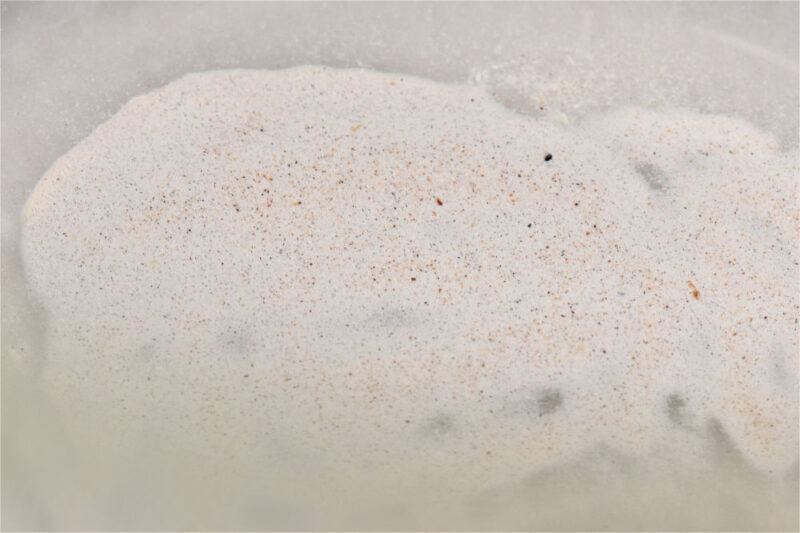
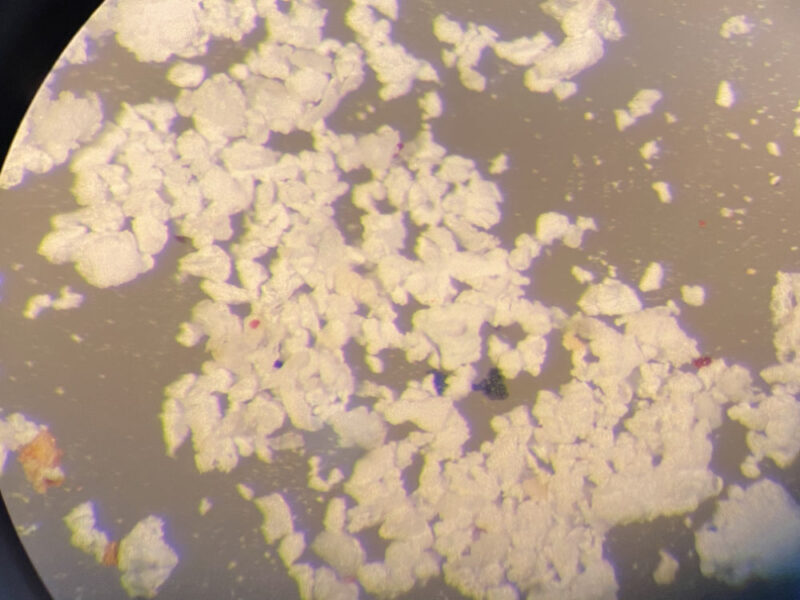
Above: Image of white powder found in an ethanol storage can and photomicrograph of the powder, 100x.
Exhibitions
Robert Clendon continues with planning and undertaking treatments along with Kyra Kim on First Nations collection items for Unsettled, opening in May. Kyra is also working with the Pacific collection team on the planning of the Bilas exhibition opening in early 2022. The planning and development phase of the AM’s new Minerals Gallery due to open in mid-2022 is now in full swing so Megan Dean-Jones is looking forward to assessing hundreds of spectacular and diverse mineral specimens in the new CC&C lab once it is up and running.
Robert and Megan have begun to document and create long-term storage of a recent acquisition of PNG cultural material.
Loans
Megan Dean-Jones has also been kept busy carrying out the conservation processing for several beautiful plant fossils to go on loan to the NMA for their ‘New Life in Australia’ gallery.
Collection Care
The IPM program has been busy dealing with the increase in pests over the summer period. Research is currently being undertaken on different trap baiting systems to target different species of museum pests.
Initial research is being undertaken into switching the Australian Museum’s environmental standards to be in line with the AICCM 2018 subtropical standards. Discussions with other institutions to gain advice have been appreciated. If anyone else has changed standards and has advice, this would be warmly welcomed. We hope that switching to new standards will reduce our environmental impact.
Australian National Maritime Museum
Events
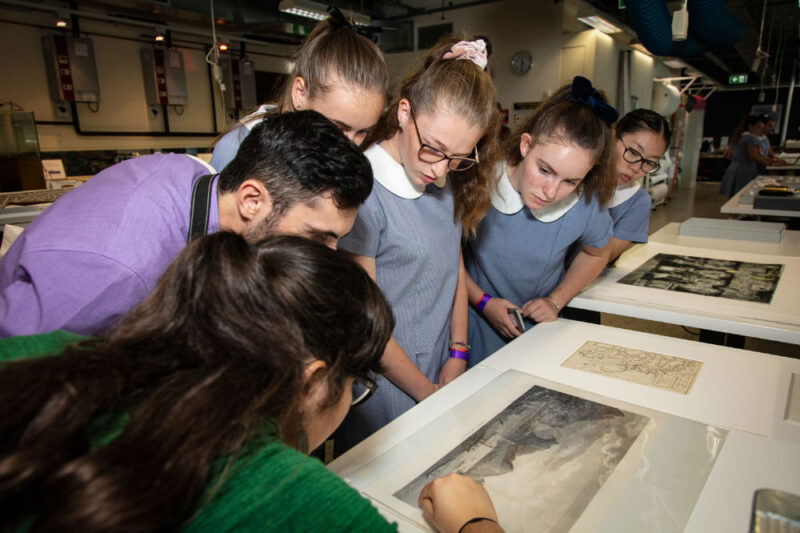
Above: Luci Ronai with Women in Science students. Image by A Frolows.
In March, the museum hosted 70 secondary students for our annual Women in Science event. Participants were welcomed into the Conservation Lab as part of a science-based tour of the museum.
Treatment projects

Above: Nick Flood positioning the Blaeu globe on the CT scanning bed. Image by L Ronai.

Above: Nick Flood viewing real-time images of the CT scan of the globe’s wooden stand. Image by L Ronai.
Luci Ronai and Nick Flood took an eventful trip to the University of Sydney to CT scan the museum’s 1602 Blaeu globe and stand. Zoe Williams and Pranish Kolakshyapati from the Charles Perkins Centre are operating the cutting-edge Siemens Artis Pheno C-Arm CT scanner, the first of its type in Australia. Initial results are impressive and show details of the internal construction of the globe and the extent of pest damage to which the wooden stand has been subjected.

Above: Cleaning the underside of the Seahawk helicopter in the Navy Gallery. Image by A Alvis.
Alayne Alvis, Jeff Fox, Nick and Luci have been involved in weekly maintenance of the Seahawk helicopter that hangs in the museum’s Navy Gallery. This maintenance includes wiping the underside of the aircraft with a microfibre pad that is attached to the end of an extendable eight-metre pole, all while standing atop a scissor lift. Just the thought of it is dizzying!
Exhibitions
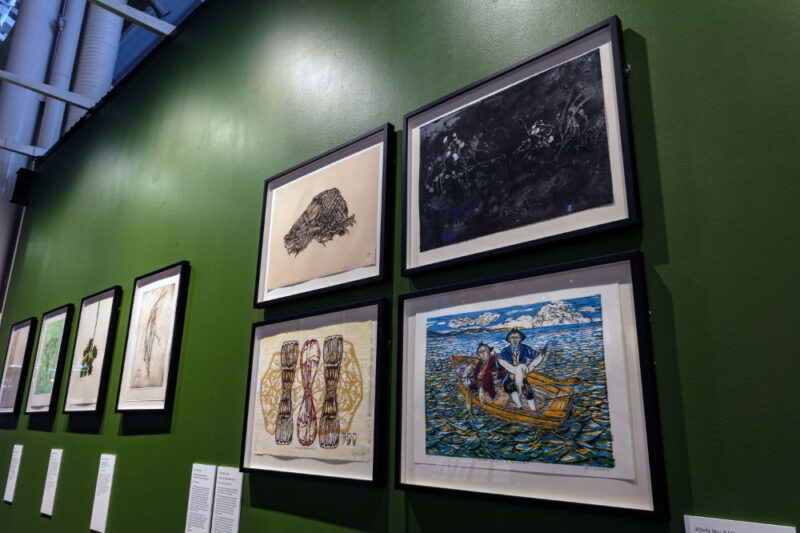
Above: Gallery view of the Paradise Lost exhibition. Image by A Frolows.
Luci recently deinstalled the Paradise Lost: Daniel Solander’s Legacy touring exhibition. The exhibition, from the Solander Gallery, Wellington, was made up of ten works on loan and eight prints from the museum’s collection.
The NGA’s Defying Empire exhibition was bumped out in early February. David Wise travelled to Sydney to deinstall the works.
Interns

Above: Collection Safety video with Agata Rostek-Robak. Image by L Ronai.
The Conservation Team has wrapped up filming of its new Collection Safety video. This short video describes the role that conservation plays in the museum and details the responsibilities that staff members have in caring for the collection. The video has been included in the museum’s induction package for new members of staff.
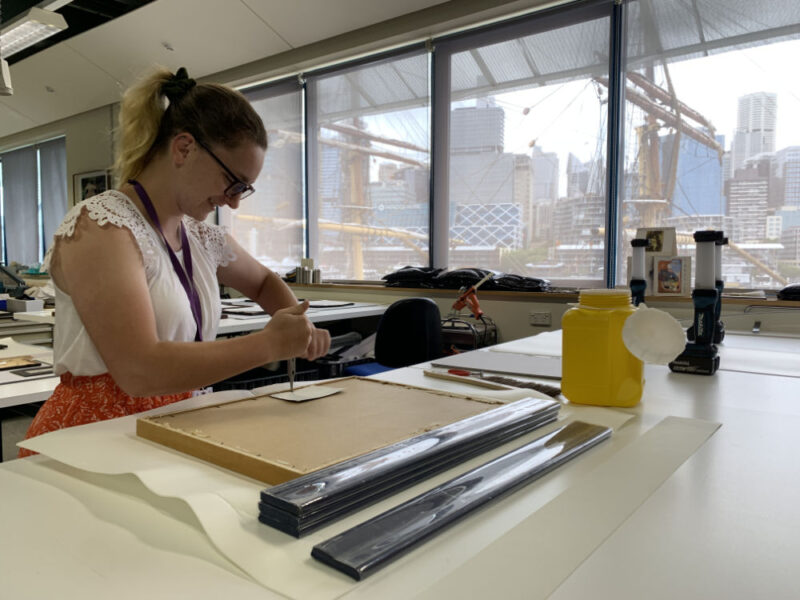
Above: Shioban Elliot deframing an object from the Alan Rice Collection. Image by L Ronai.
In the last few months we have been blessed with two conservation interns. In December, Siobhan Elliot, a postgraduate student from the University of Canberra, worked with both Conservation and Registration to treat and process the many photographs of the Alan Rice Collection. Her duties included deframing, treatment and documentation. Yen Lee, also from the University of Canberra, joined us in January and February. She was involved in many of the routine tasks of a conservator, including condition reporting, treatment, storage and environmental monitoring. Thanks to you both and good luck with your studies.
International Conservation Services
Objects and Outdoor Heritage
Conservators do not often find themselves interacting with the public on controversial issues. The recent experience of our US conservation colleagues in the wake of vandalism to confederate statues is a case in point – check out the AIC paper on contested monuments
So it has been interesting for ICS to experience two such projects within the last couple of months.
The first project involved the removal for conservation of a concrete plaque commemorating the 19th-century farmer, politician and whaler Ben Boyd. Located in Neutral Bay, the plaque has been losing paint and detail for some years and the local council required it to be conserved. Ben Boyd made much of his fortune by enslaving South Sea Islanders as labourers, and the removal of the plaque by ICS conservators Sergio Merida and Amy Walsh caused some consternation to the locals, concerned that political correctness in the wake of the Black Lives Matter movement was the reason for its removal. All was resolved through the local historian arriving to confirm the plaque will be returned after conservation (leaving the council to deal with the broader issue separately).
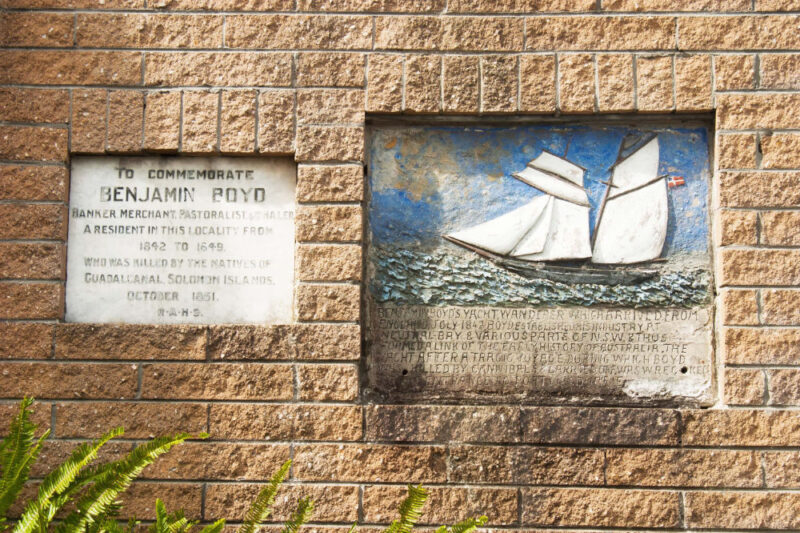
Above: Ben Boyd plaque. Photo by International Conservation Services.
The second project involved the removal of the Explorers Tree in the Blue Mountains. It is purported to be the last surviving tree on which Gregory Blaxland, William Lawson and William Charles Wentworth, the explorers who achieved the first known successful crossing of the Blue Mountains by European settlers, carved their initials in 1813. The unfortunate tree, a Blue Mountains ash (Eucalyptus oreades), was dead by at least 1892 and since then has been variously partly cut down, filled with concrete, vandalised, burnt in bush fires and an arson attack, and run into by at least two cars. In late February this year it was deemed close to collapse into the adjacent Great Western Highway. ICS has undertaken a number of assessments of the Explorers Tree over the past eight years, and we were called in at very short notice (four hours) to be present as it was removed overnight. Julian Bickersteth undertook an all-nighter, watching and advising as the tree and the adjacent stone wall were removed. The local heritage community group was also on hand to film every move. Julian and Nicola Ashurst are now resolving what can be salvaged and conserved for site interpretation.
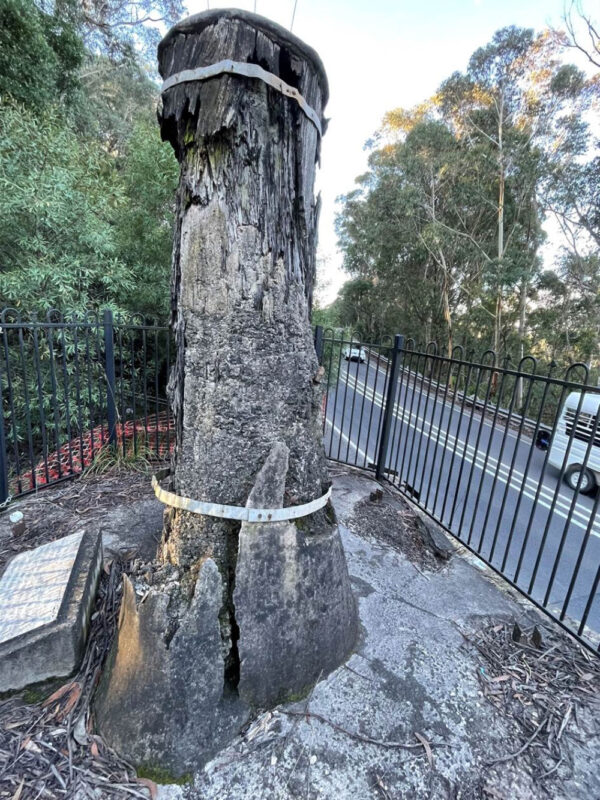
Above: Explorers Tree before removal. Photo by International Conservation Services.

Above: Explorers Tree being removed at night under the supervision of Julian Bickersteth. Photo by International Conservation Services.
As part of ICS’ ongoing work on the bronzes of Sydney, the statue of Queen Victoria outside the Queen Victoria Building (QVB) has been conserved by Wendy Reade, Sergio Merida, Claire Rowson and Amy Walsh. The statue has had a chequered history, having been commissioned for Leinster House, Dublin, the Irish seat of Parliament, in 1908, but removed once Ireland gained independence. It sat in an Irish carpark for many years before being transported to Sydney in 1987 to sit outside the restored QVB (which itself was almost demolished to become a carpark!).

Above: Amy Walsh, close and cosy with Queen Victoria. Photo by International Conservation Services.
Textiles
In the Textiles department Christina Ritschel has been stabilising tears in a possum-skin cloak from the University of Technology Sydney. She has also been removing adhesive residue from a pair of boxing shoes from the Orange Regional Museum and creating internal supports. The big challenge of the month was mounting a large Chinese robe for framing. A padded internal support was created and rare-earth magnets attached. Corresponding rare-earth magnets were attached to the backing board, which was then padded and covered with backing fabric. The Chinese robe could then be securely placed on the board ready for framing.
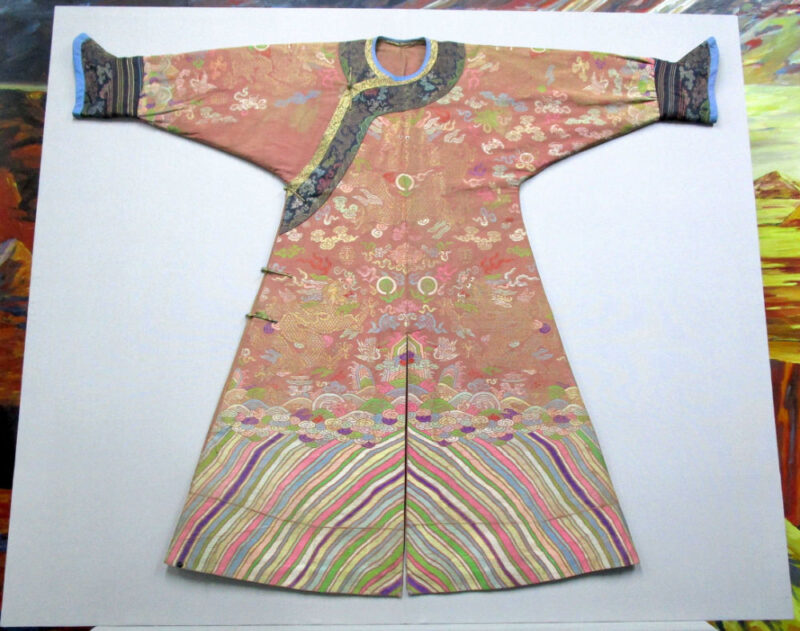
Above: Chinese robe mounted and ready for framing. Photo by International Conservation Services.
Furniture
Oliver Hull and Shane Weichnik in the Furniture department have completed work on an extremely fine mid-18th century gilt frame, which arrived at ICS in 35+ pieces. Also completed is the conservation of a sculpture from Indigenous artist Garth Lena. Work continues on the removal of a modern varnish on a significant escritoire. We have also recently taken delivery of a very fine collection of mid-18th century furniture.

Above: Cleaning of test patch on an 18th-century English Japaned clock case. Photo by International Conservation Services.
Paintings
The Paintings department has been working on important artworks from the collection at St John’s College by After Murillo. In preparation for an upcoming exhibition at the NGV, maintenance work has been completed on New England Regional Art Museum’s Mosman Bay by Tom Roberts, including cleaning and consolidation of the old overpaint. One very large item has been keeping both the Paper and Paintings departments busy – a giant globe from Presbyterian Ladies College. Work on the globe, which measures two metres in diameter, included mechanical varnish removal and consolidation of lifting surfaces. The eight separate globe pieces will now be joined back together and revarnished.
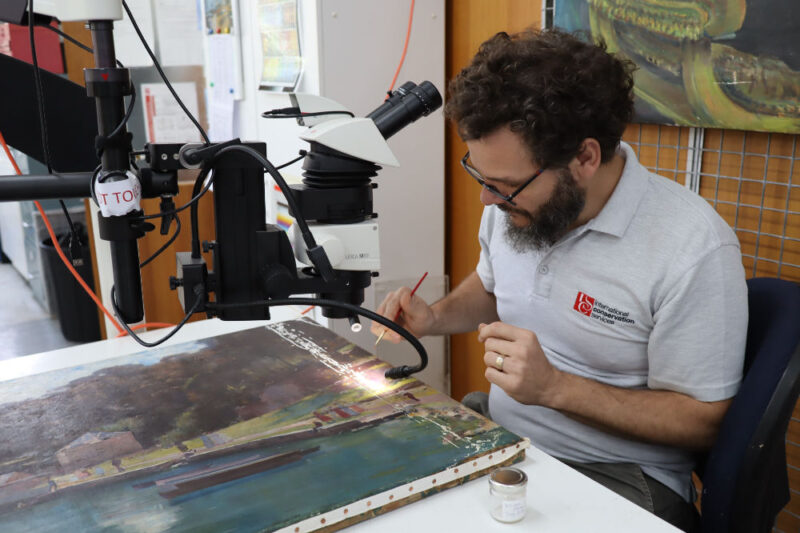
Above: Matteo Volonte inpainting Mosman Bay by Tom Roberts. Photo by International Conservation Services.
Paper
Our Paper conservators have been working on the very large Bradfield Map. The map, measuring three by four metres, had to be deframed and disassembled on-site so it could be moved out of the building in which it is housed. Treatment in the lab is now complete, and the reinstallation requires a big team (Katie Wood, Caroline Whitley, Jochen Letsch, Yolanda el Khouri and Oliver Hull). In the meantime, Suati Rojas has been experimenting with cyclododecane on a Brett Whiteley artwork. The Paper team is constantly learning new techniques, and recently participated in a workshop with Kay Soderlund on parchment repairs and making gelatin loose. Another stand-out project this month for Paper has been three lovely watercolours of kookaburras by Neville Cayley.
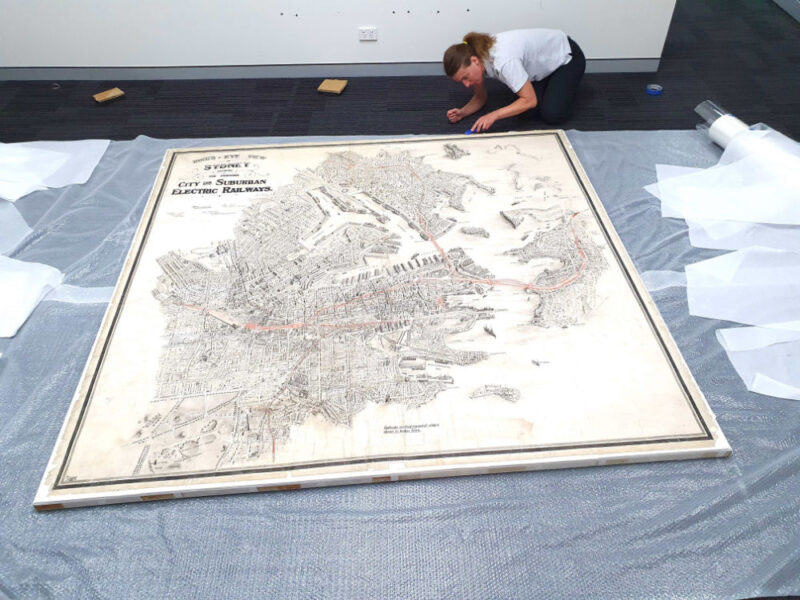
Above: Katie Wood examining the Bradfield Map (removed from frame). Photo by International Conservation Services.
ICS refurb
From October 2020 to January 2021, ICS’s labs and offices in Sydney underwent a refurb to create more efficient and safer workspaces. A new roof for the building was installed, a new ceiling was installed throughout the first floor, all four labs had fume extraction arms installed, a new photography area was created, the Paintings lab was opened up to create extra space, and the Paper lab has a new suction table. On the ground floor, we have new carpet throughout, and the Objects lab has new benches and a new configuration to provide more space. Our basement area also underwent a major renovation, with improved lighting and space for equipment and storage. Our conservators showed extraordinary flexibility in sharing labs from time to time, as their home lab went through its transformation!

Above: Paintings Lab – packing up for the refurb. Photo by International Conservation Services.
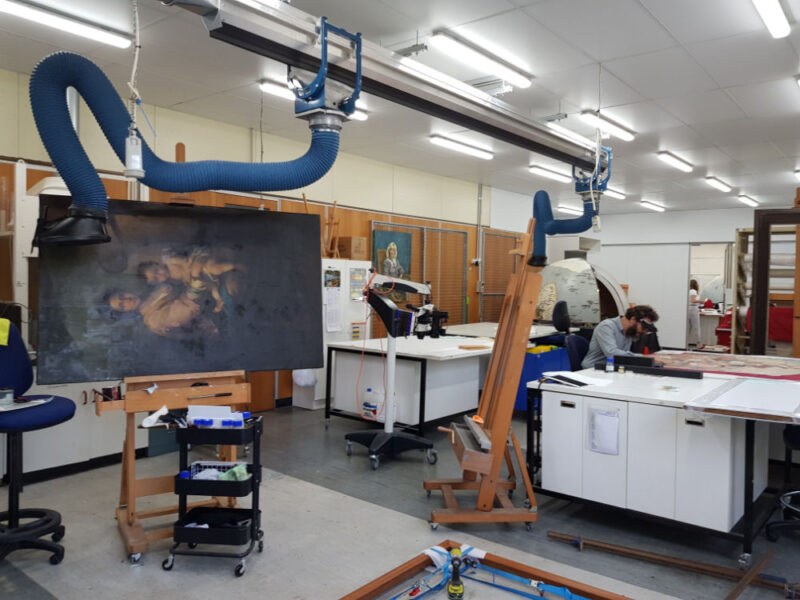
Above: Paintings Lab – after the refurb. Photo by International Conservation Services.

Above: Paper Lab after the refurb (with Bradfield Map and pieces of the large globe). Photo by International Conservation Services.
Museum of Applied Arts and Sciences (MAAS)
Staff changes
Brooke Randall has been appointed Lead Conservator, Hazards. In addition to managing hazardous material in the Museum’s collection, Brooke will be facilitating conservation research.
Paper conservators Karina Lavings and Beate Yule have joined the Collection Relocation and Digitisation (CRD) Conservation Team. They will be treating collection items stored at the Museum’s Ultimo location and at the Museum’s Discovery Centre in preparation for digitisation.
The CRD Assessment Team welcomes assistant conservator Emilia Zambri. The Assessment Team is currently recruiting additional assistant conservators and we encourage students and recent graduates to apply.
Madika Penrith, from the CRD Aboriginal and Torres Strait Islander (ATSI) Team, is working in the conservation department one day per week. She is currently assisting Margot Murray with cleaning ceramics in preparation for digitisation.
Trish Stokes has left MAAS to undertake a project at the University of Melbourne. Trish was an immense agent of change and will be greatly missed. The conservation department wishes her all the best in her new role and hopes to work with her again in the future.
CRD Special Collections Team Leader Monica Podesta has also left the museum.
Project and treatment update
While ceramics conservator Margot Murray has been stabilising a selection of 19th-century ceramics in preparation for transport, metals conservator Skye Mitchel has been treating a writing desk made from tortoiseshell, ivory and lead.
Chris Redman has been preparing a large collection of film and magnetic media for digitisation, including a rare archive of Dick Smith’s Super 8 films. He has also undertaken preservation of newly acquired USB devices.
Brooke Randal and Jessie Gray have been treating a glass chandelier and a collection of irons containing asbestos. They have also been developing a battery management policy and rehousing cellulose acetate and nitrate negatives in the MAAS Archive in preparation for cold storage.
Bronwyn Dunn has been working with Vanessa Thorne, Anne-Louise Dadak and Sharon Mifsud on the Treasure Islands Digital Pasifika. This project is a collaboration between I.C.E Pasifika, MAAS and cultural experts from Fiji, Tonga, Samoa, New Guinea, Aotearoa, Solomon Islands, Kiribati and Cook Islands. This project has enabled engagement with the different communities from Oceania by accessing objects in the MAAS Collection particular to each nation. This has been a wonderful first-hand opportunity to learn how some of our objects have been made, what they are made of and their tangible and intangible cultural heritage.
Exhibitions
Vanessa Pitt has worked closely with members of the CRD ATSI team to de-install Linear. Teresa Werstak and Vanessa are now working on Iranzamin (Land of the Persians), the first survey exhibition of Persian arts and crafts acquired by the Powerhouse Museum since its founding in 1880.
The MAAS 2021 exhibition calendar was recently announced. Upcoming exhibitions include Clay Dynasty, which celebrates studio ceramics in Australia, and The Invisible Revealed, which highlights research undertaken in partnership with the Australian Nuclear Science and Technology Organisation (ANSTO).
Loans
COVID-19 has had a large impact on the Museum’s outgoing loans program. Loans have been rescheduled several times over, scaled back and/or stuck in storage for months.
Frances Fitzpatrick and Tim Morris will soon install a collection of scientific instruments and colonial material at Old Government House, Parramatta, in the exhibition Enquiring Minds: exploration and discovery in colonial New South Wales.
Work also continues on loans to the Museum of Australian Democracy and the Newcastle Museum as part of their re-development projects.
O’Sullivan Conservation
Staffing
The Christmas holidays and New Year period have certainly been busy. The new premises are fitted out and functional and everyone is settling in well, with the team set to expand with a conservator position currently advertised
Treatment projects
The University of New South Wales provides O’Sullivan Conservation with the opportunity to work on several Tom Bass sculptures. The most recent was a major treatment undertaken in December 2020 on Falconer (1955), located at the main entry to the Old Main Building. This was the first time the sculpture has been treated since 2010.

Above: Falconer during treatment: Eoin during coating removal.
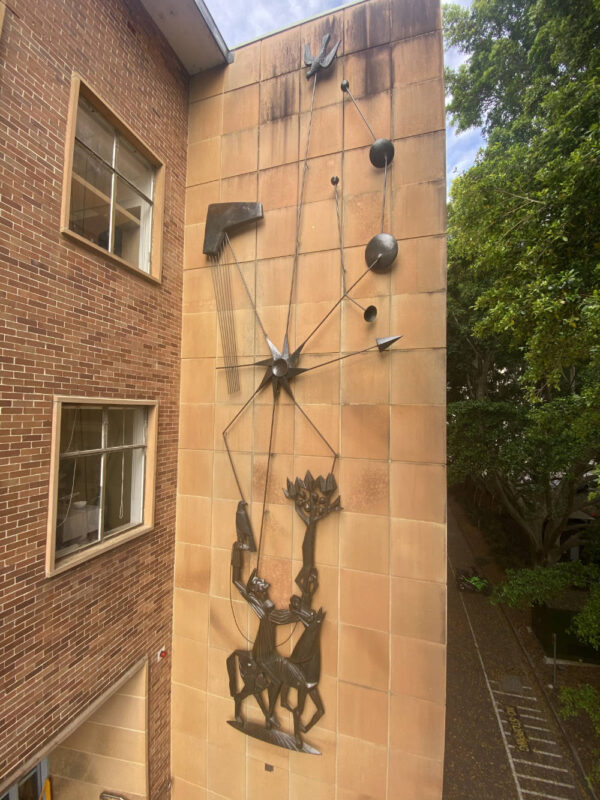
Above: Falconer after treatment.
After having the Haberfield Roll of Honour in storage at O’Sullivan Conservation’s premises for the last 12 months, it has finally been installed in its new location above a doorway in the developed Haberfield library. Eoin and the team relished the challenge of installing such a large piece at height.
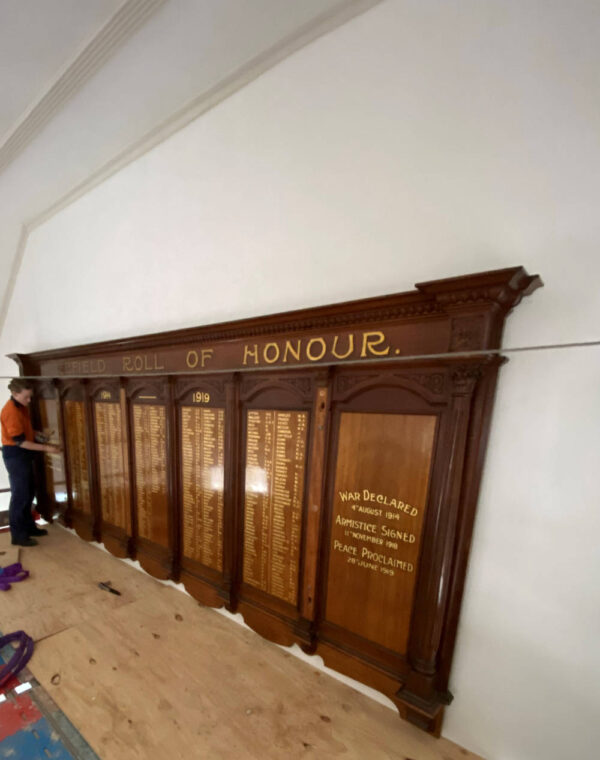
Above: Haberfield Roll of Honour: Kaleigh inspecting the fixings.
Parramatta Heritage Centre
Natalie Cassaniti, Cultural Collections Officer, Parramatta Heritage Centre, has been developing a research project aimed to engage the broader community, share historical, contemporary and cultural stories online, and develop awareness of the significance of cultural material.
‘A–Z Things @ Parramatta’ comprises a selection of 26 artefacts from the Cultural Collections showcased in a short video series presented by the Cultural Collections Officer. The artefacts were selected from the first letter of their names, from A to Z.
Each episode, a mystery object is revealed along with its unique story about its significance and relationship to Parramatta. The presenter also invites the community to respond by sharing the story of a treasured object from within their homes or collections.
Natalie was inspired to develop the interactive outreach program during the lockdown period last year, aiming to provide a unique opportunity to explore and broadly share artefacts that may otherwise not be accessible to the public for various reasons.
The series will be launched on Monday 8 March and episodes will be released fortnightly. Check out the Parramatta History and Heritage website for more details.
Can you guess the first mystery object starting with the letter A? The clue is: ‘an early implement for splitting timber!’
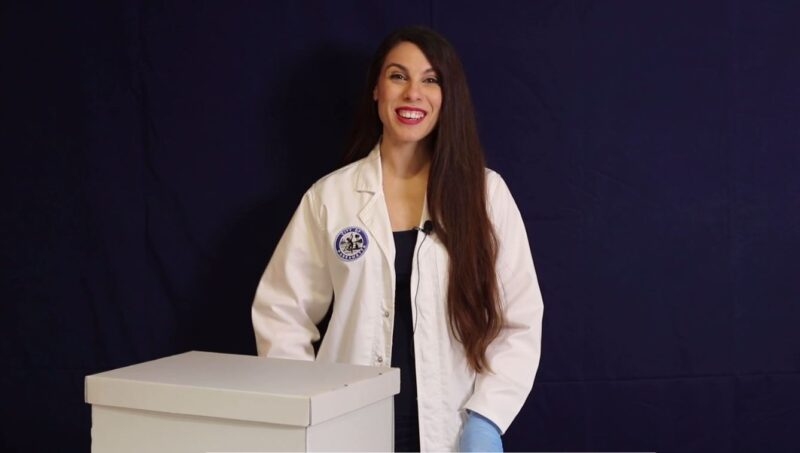
Above: Natalie Cassaniti, Cultural Collections Officer, Parramatta Heritage Centre, presents ‘A–Z Things @ Parramatta’. Photo by Natalie Cassaniti.
State Library of New South Wales
The Collection Care branch at the State Library of New South Wales has officially moved into the newly built and much anticipated Ainsworth Conservation Laboratory. Two former library book stacks and a plant room in the oldest heritage-protected part of the building were transformed for the new conservation labs.
Since the completion of the build in February 2021, each team has been steadily migrating to the new labs. It is the first time the Collection Care Branch has been consolidated into one single space in the Library as in the past the branch has been split across multiple lab spaces in the Mitchell Library building. It is a considerable improvement from our previous conservation labs; the branch is now able to enjoy ample bench-top space, natural light coming from large original heritage windows, new furniture and facilities and dedicated spaces for conservation activities – including an analytical and photographic room, wet space for aqueous treatments and a lab for solvent usage. The Solvent Lab can also act as a second wet treatment area and houses the suction table. Staff are also excited about new equipment to arrive soon, including a down-draft table, a tilting light-box table and two large mobile sinks, one in the wet area and one in the solvent lab. The move has been relatively smooth, with all staff now adjusting to the new space, workflows and working alongside one another.
The new world-class conservation laboratories have been generously funded by Mr Len Ainsworth AM and Mrs Gretel Ainsworth through the State Library Foundation. It has been a momentous project for the branch and Library over the past few years. While the branch settles into its new laboratories, the Library will refurbish the existing Domain Lab to house large framing, mounting and rehousing equipment and to enable this work to be kept separate from conservation work. The Shakespeare Lab will be re-purposed as a much-needed dedicated quarantine room for screening and processing incoming acquisitions.

Above: Construction in progress – view towards east showing original Glass Stack shelving and Wet Area. Photo by Jonathan London.
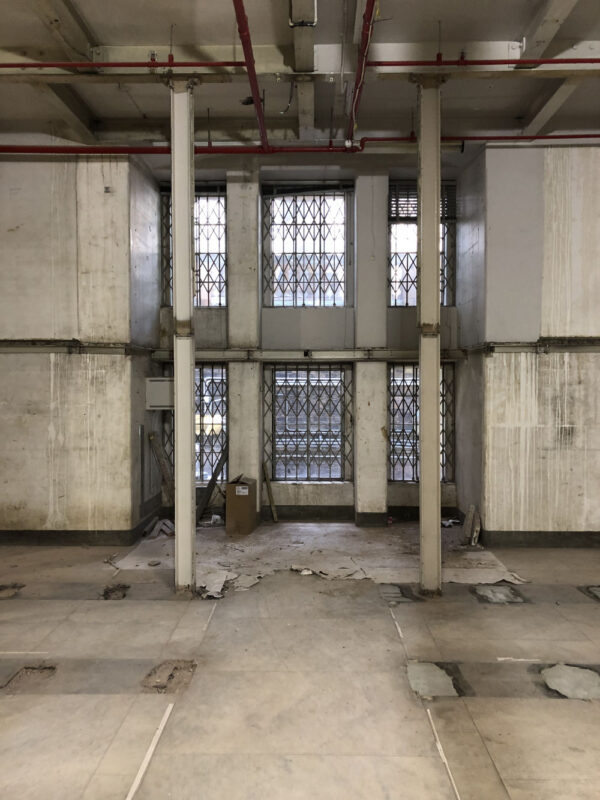
Above: Construction in progress – view of original heritage windows looking out to Macquarie Street. Photo by Jonathan London.

Above: Ainsworth Conservation Laboratory after construction – view towards north showing original heritage walls. Photo by Jonathan London.
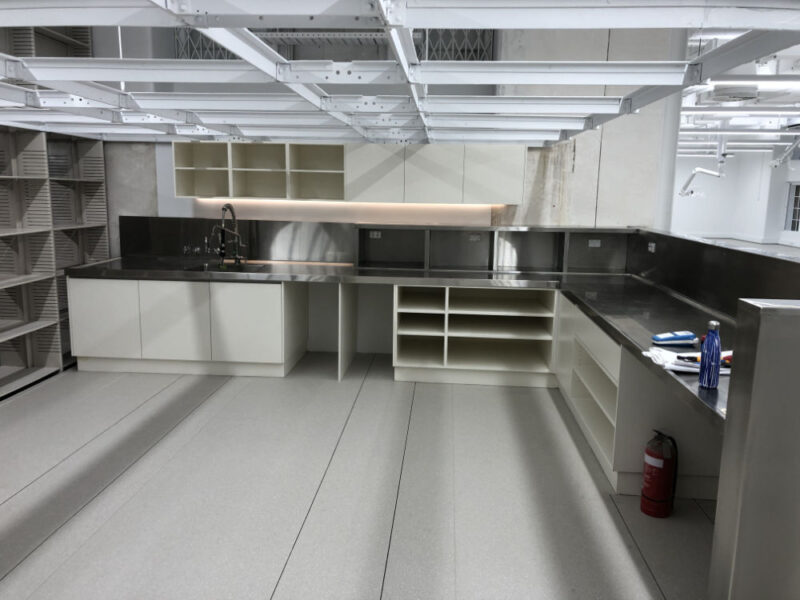
Above: Wet Area in the new conservation labs after construction. Photo by Jonathan London.
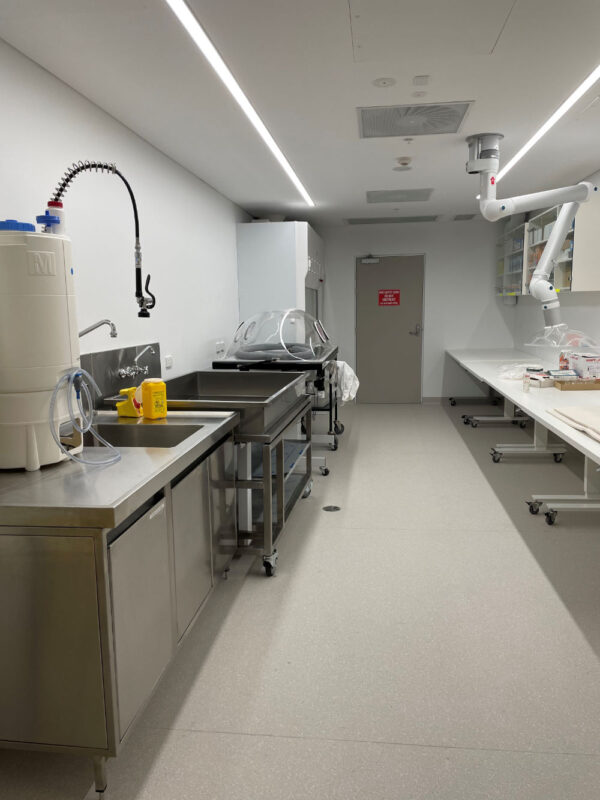
Above: Solvent Lab in the Ainsworth Conservation Laboratory after construction. Photo by Hoa Huynh.

Above: Collection Care staff in the Ainsworth Conservation Laboratory, view from southern end of the space. Photo by Hoa Huynh.

Above: Collection Care staff in the Ainsworth Conservation Laboratory, view from northern end of the space. Photo by Hoa Huynh.
South Australia
Artlab
Staff changes
Artlab welcomes five new staff members: Victoria Thomas, Carolyn McLennan, Zora Sanders, Laura Daenke and Dr Maria Kubik.
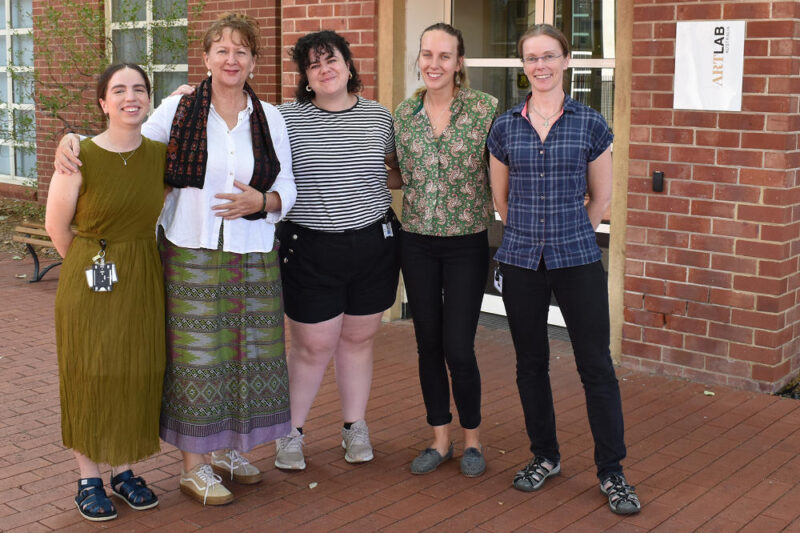
Image 1: Group photo of the new Artlab staff members
Victoria has recently joined Artlab on the textiles and preventive teams. She joins us after three years at Grimwade Conservation Services, where she worked with the textiles and objects teams on a range of projects for the University of Melbourne’s cultural collections, various collecting organisations around Victoria, and private clients. She is hoping that, in addition to her conservation training and commercial experience, her background in patternmaking and garment construction will make a positive contribution to the Artlab team.
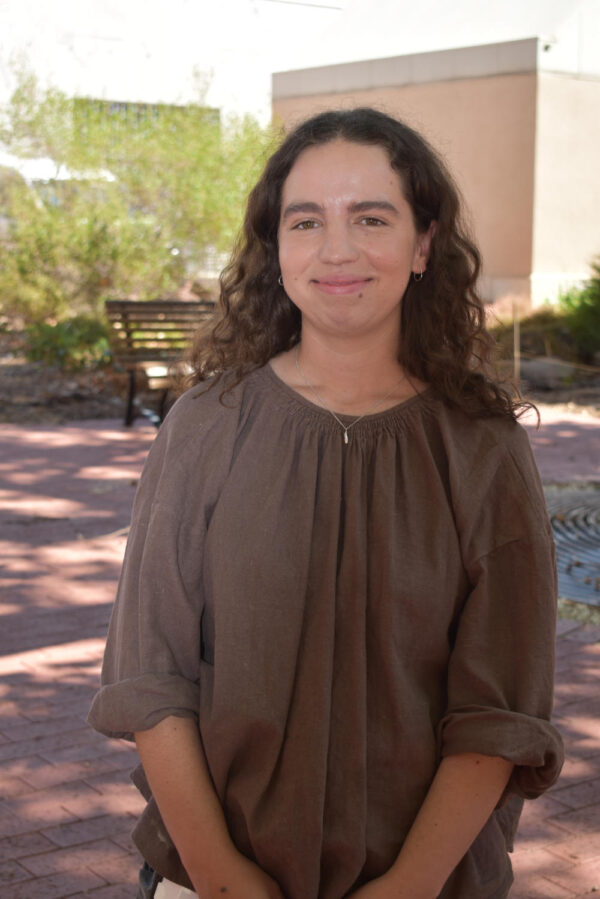
Image 2: Victoria Thomas
The objects team is delighted to welcome two new colleagues into the lab, Carolyn McLennan and Zora Sanders, who are working with us on short-term contracts whilst Sophie Parker is on four months leave.
There has been some more shuffling around the Objects Lab as Renita Ryan has returned to her role as Principal Conservator and Jo Dawe to her role as Objects Conservator. We are grateful to have Carolyn and Zora with us, assisting in getting through our backlog of rehousing, various treatments and exhibition preparation work.
Carolyn is an objects conservator and comes to us from Darwin where she has recently been working as an independent conservator for people caring for collections in regional and remote areas of the Northern Territory and surrounding regions. Carolyn has worked as a contract conservator and collection manager at the Museum & Art Gallery of the Northern Territory and at other collecting institutions.

Image 3: Carolyn McLennan
Zora is an objects conservator from Melbourne. She completed her master’s degree at the Grimwade Centre in 2019 and Postgraduate Diploma in the Conservation of Metals at West Dean College in 2020. She has undertaken work placements at the Australian War Memorial and Royal Museums Greenwich, UK. She has a background in editing and literary publication, was the AICCM web editor from 2015 to 2020 and is currently AICCM’s Communications Officer.
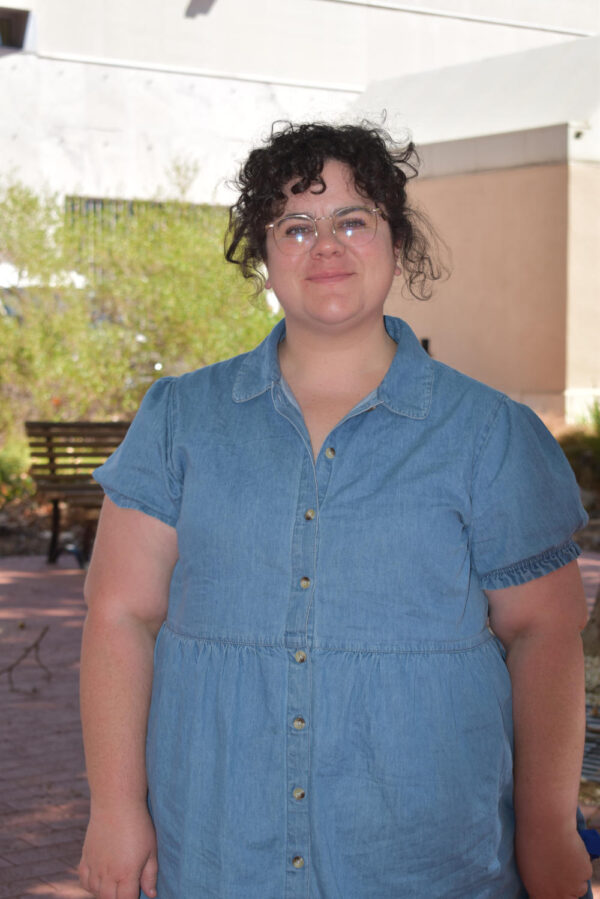
Image 4: Zora Sanders
The paper & books team welcomes new member Laura Daenke in the position of Paper Conservator. Laura has a Bachelor of Heritage, Museums and Conservation from the University of Canberra and a Master of Cultural Materials Conservation, specialising in paper conservation, from the University of Melbourne. During her master’s, she completed a three-month internship in the Paper and Photo Department at the Rijksmuseum in Amsterdam. Laura has worked in several conservation studios around Australia, including the National Archives of Australia, the State Library of Queensland and the Queensland Art Gallery and Gallery of Modern Art.

Image 5: Laura Daenke
Dr Maria Kubik joined Artlab’s paintings team recently, moving from Perth after many years at the Art Gallery of Western Australia. She’s very happy to again be working in a large collaborative environment, and hopes to get up to speed soon on Artlab’s many analytical facilities. Current projects include the conservation of a large heavily damaged Greek Orthodox panel painting, and preparation of numerous works for AGSA’s Dusan Marek exhibition.
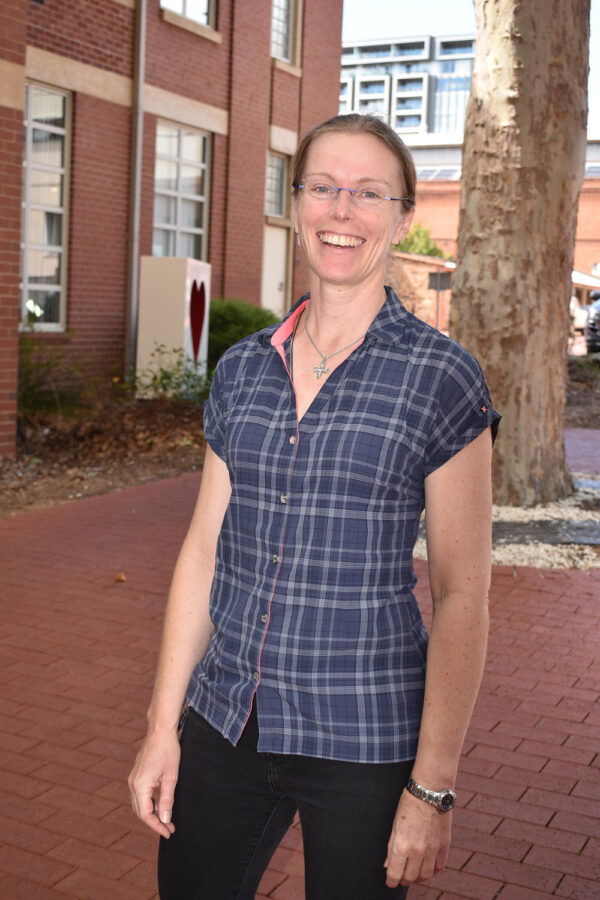
Image 6: Dr Maria Kubik
Professional news
Ian Miles, Artlab’s Senior Metals Conservator, received a High Achievement honour at the Department of the Premier and Cabinet (DPC) 2020 Employee Recognition Awards. The awards ceremony was held on 29 January 2021 at Her Majesty’s Theatre, Adelaide.
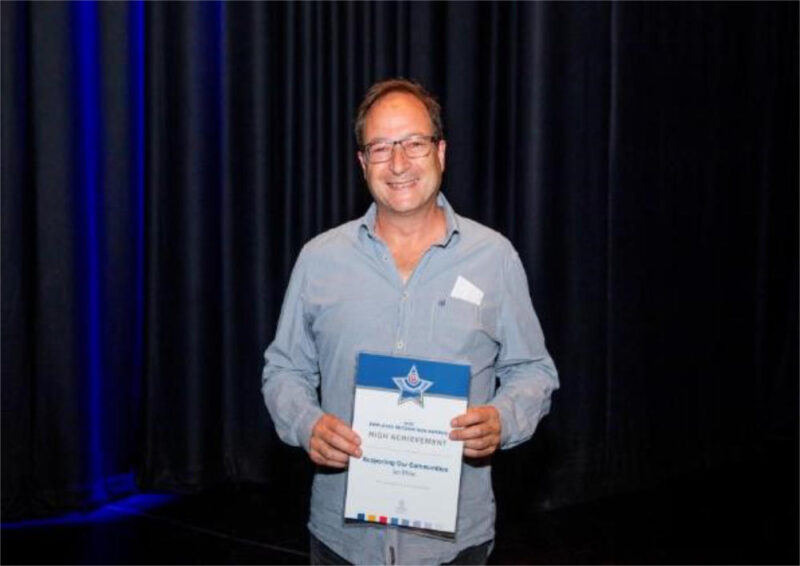
Image 7: Ian Miles awarded at Her Majesty’s Theatre, Adelaide.
Ian’s award was in the ‘Supporting Our Communities’ category for his swift response in the specialist removal of graffiti from A Day Out by artist Marguerite Derricourt, affectionately known as the Rundle Mall Pigs, which occurred in October 2020.
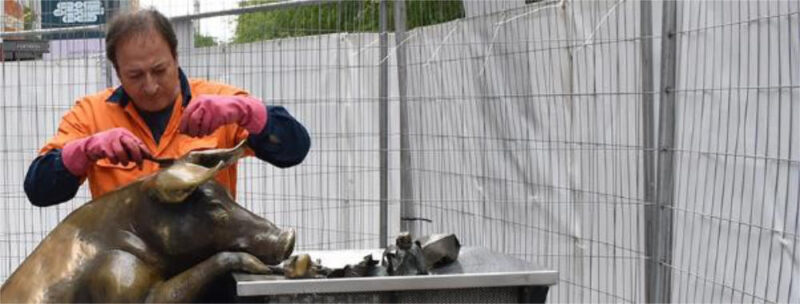
Image 8: Ian Miles at work on the sculpture A Day Out.
Heather Brown, Assistant Director, has recently been awarded a PhD. The abstract of her thesis and the link to the full text are reported in the research section, below.
Roberto Padoan, Principal Conservator Paper and Books, joins a number of Artlab staff in being awarded professional membership of AICCM.
Treatment projects
Paintings
Baptism of Christ, painted by Robert Dowling in 1863, was housed from the 1930s in a church in Scotland. The Art Gallery of South Australia (AGSA) acquired the painting in 2019 before the church was demolished. Dowling was Australia’s first colonial trained artist and first expatriate artist, who left Australia in the 1850s and built a successful career in London.
The painting had never received conservation treatment except for a coat of varnish, which we speculate was applied when the painting was sent from London to Scotland. This varnish had sealed in pollutants acquired in London from traffic, coal fires and gaslights, forming a visible crusty layer over its surface. The church was very damp, causing mould and mildew and further disfiguring the painting’s surface. Dampness caused shrinkage in the canvas, causing paint to erupt from the surface as ridges of loose paint. The back of the painting was thick with sooty pollutants and mildew, and fortunately the artist had had the foresight to apply a reversed loose lining protecting the painted canvas. However, it had rotted along the top edge, causing the painting to slump out of the frame.
The conservation of Baptism of Christ was complex due to the large size of the painting and its damaged condition. The first stage of treatment was to brush vacuum the front and back of the painting removing loose pollutants followed by an aqueous clean to eliminate grime. Solvent cleaning removed the old varnish layer and, finally, repeated aqueous cleaning dissolved stubborn grime ingrained in the paint layer.
Loose areas of paint were temporarily faced with Japanese tissue using a wax-based adhesive and the canvas was removed from the stretcher onto a specially made support. The areas of loose paint were impregnated with consolidant from the back and pressed flat, fragile tacking edges were reinforced by strip lining, and distortions in the canvas were pressed out. Because the loose lining carried an inscription by the artist it was also cleaned, consolidated and its tacking margins strengthened. Both canvasses were placed on the stretcher. The painting was given a conservation-grade varnish, and a small amount of retouching completed the work.
The original frame was quite significant as it was custom made for the painting with religious iconography at top centre, with cherubs in the corners and biblical text on a panel at bottom centre. The frame, covered in grime and with one of the cherubs missing, had considerable areas of worn gilding and a large amount of damage to many elements.
The frame received a thorough cleaning treatment and all elements of iconography were strengthened and repaired. A new cherub was cast and attached followed by an extensive gilding process reinstating large areas of the frame. Baptism of Christ is now on display in Gallery 3 at the AGSA, Adelaide.
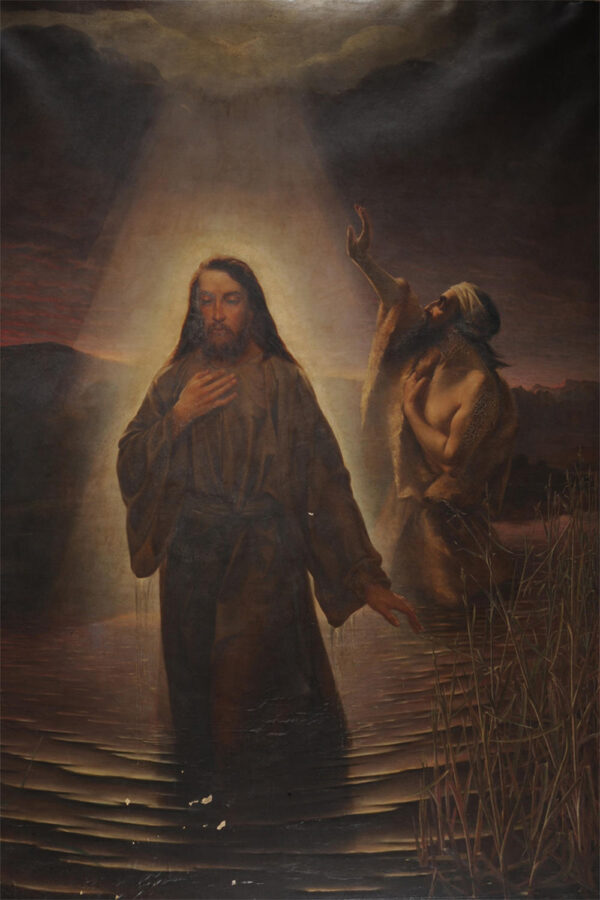
Image 9: Before treatment. Robert Dowling, Australia/Britain, 1827–1886, Baptism of Christ, 1863, London,
oil on canvas, 222.6 x 161.0 cm (sight), Gift of Thomas Coats Memorial Church Trustees through the Art Gallery of South Australia Foundation 2019, Art Gallery of South Australia, Adelaide, 20191P1.
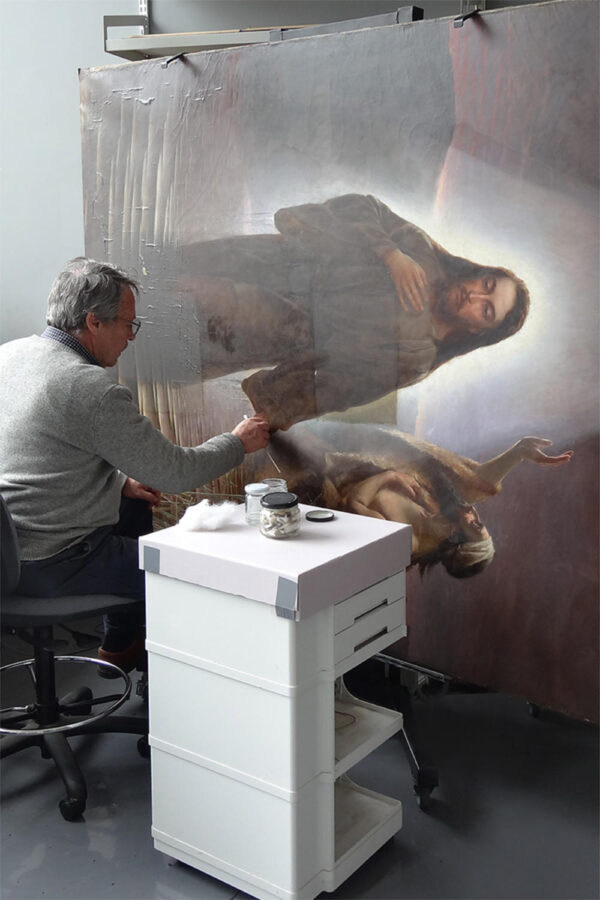
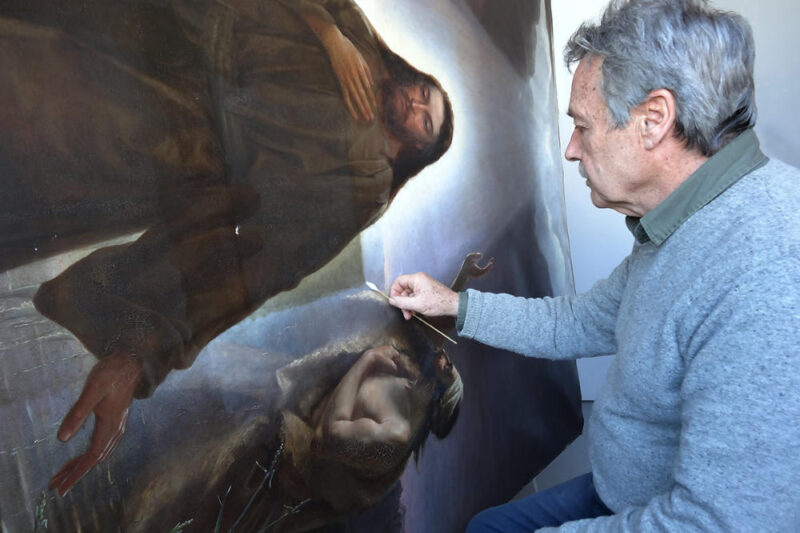
Image 10 and 11: Chris Payne, Senior Paintings Conservator, removing ingrained grime.
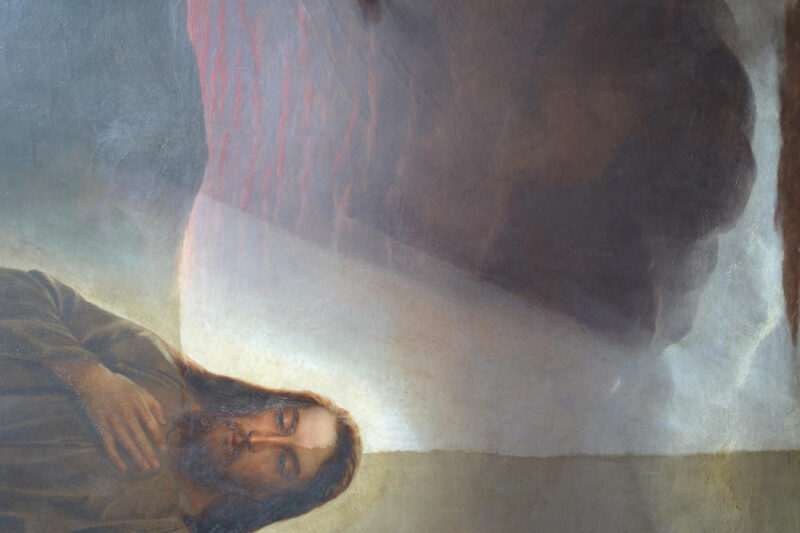
Image 12: Detail of canvas showing contrasts between before and after cleaning.

Image 13: Detail of frame showing contrasts between before and after cleaning.

Image 14: Cherubs before gilding process.
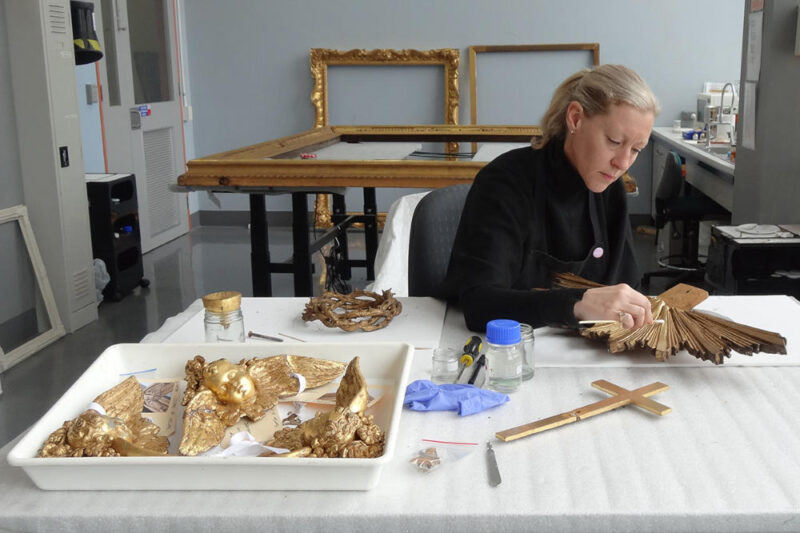
Image 15: Rosie Heysen, Paintings and Frames Conservator, cleaning light burst element from the frame.
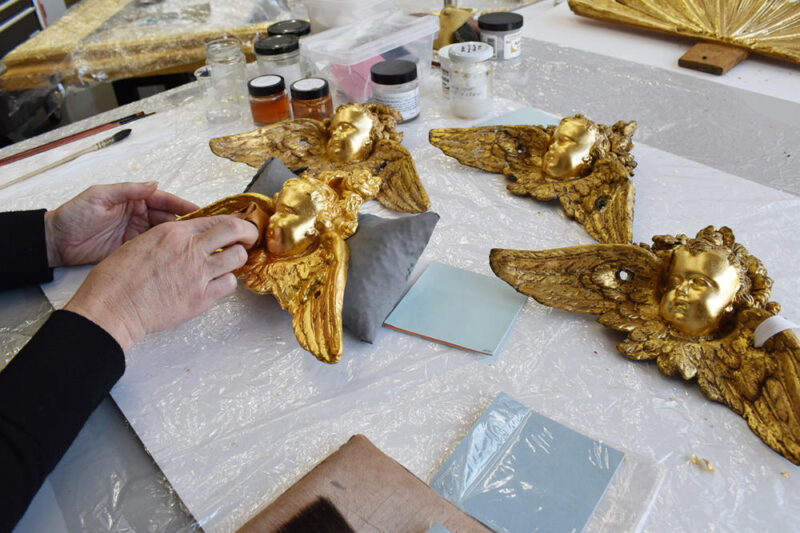
Image 16: Rosie Heysen gilding existing cherub elements.
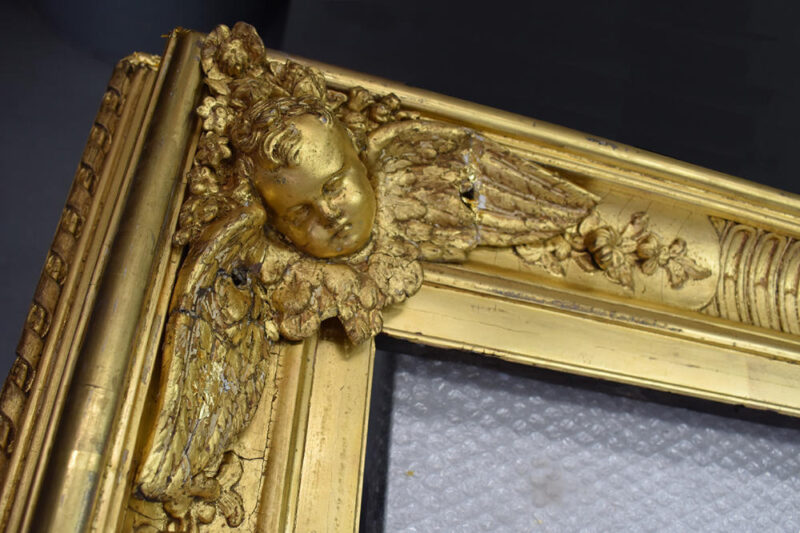
Image 17: Detail of existing cherub used for casting missing element.
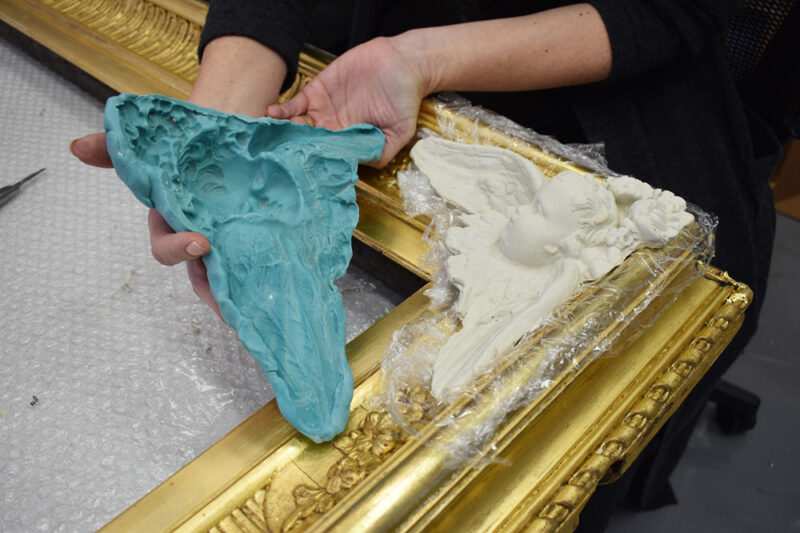
Image 18: New cast custom-made cherub in place.
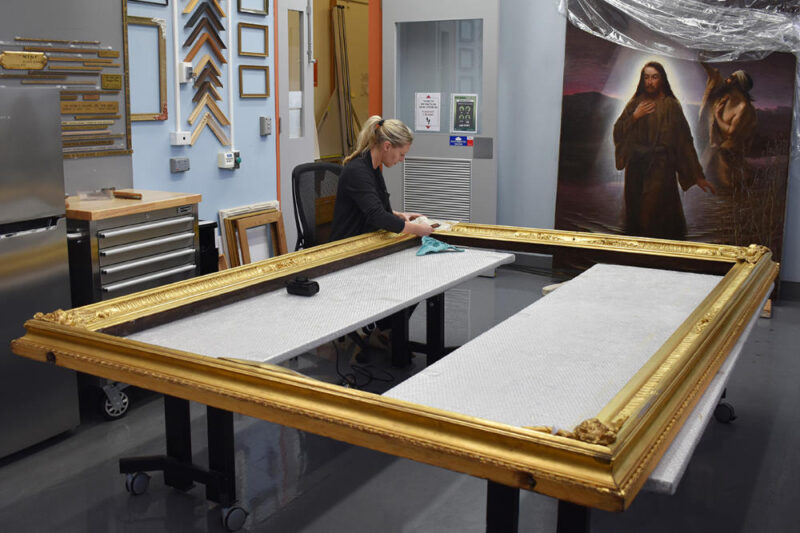
Image 19: Rosie Heysen attaching new cherub to frame before gilding.
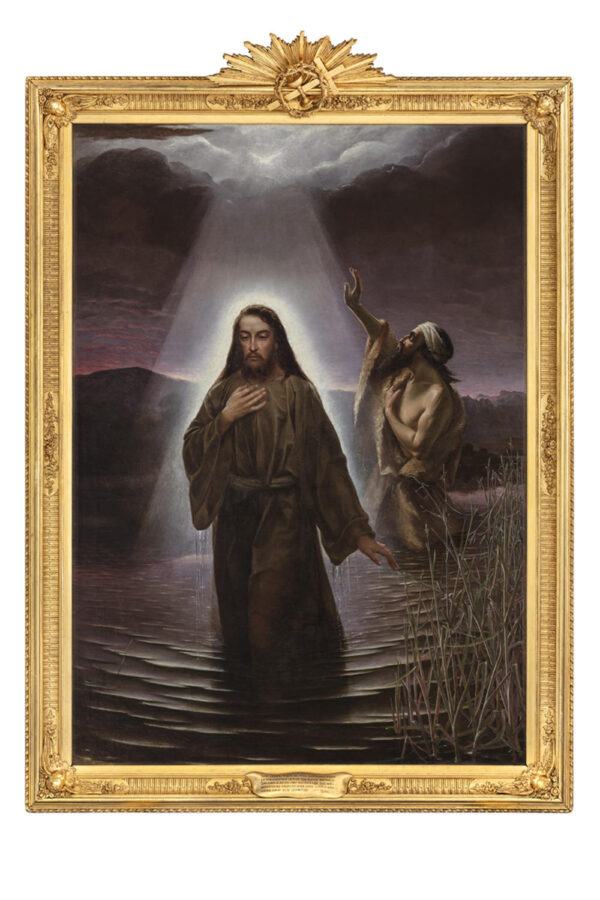
Image 20: After completion of conservation treatment. Robert Dowling, Australia/Britain, 1827–1886, Baptism of Christ, 1863, London, oil on canvas, 222.6 x 161.0 cm (sight), Gift of Thomas Coats Memorial Church Trustees through the Art Gallery of South Australia Foundation 2019, Art Gallery of South Australia, Adelaide, 20191P1.
Objects
Filipa Quintela has been working on a polychrome wooden sculpture of Saint Anthony holding Christ child in one of his arms, belonging to one of Adelaide’s cathedrals. The treatment includes overall cleaning, some infilling and in-painting of losses and reconstruction of two missing fingers of Christ. After treatment and improvement of aesthetic appearance, St Anthony will return to his place within the cathedral to be admired by the parishioners.
Our Netley-based Objects team—comprised of Isabelle Waters, Helen Behrens, Jamie Hampton, Fiona Hurel and Kenny Monger—met a major milestone in completing the rehousing of approximately 5000 spears from the South Australian Museum’s Humanities Collection.
To complete this task, the team worked alongside the SA Museum’s collection managers who, over a period of five months, regrouped the spear collection into regional areas so that they could be individually preserved and rehoused in custom-made spear boxes.
This comprehensive and diverse collection includes spears that date from the late 1880s to the present day. Regional variations are evident in the technology used, including barbed and un-barbed, stone and stingray barb styles, reflecting both desert and coastal styles and capturing the differing object purposes, from ceremonial to functional. Additional materials used in manufacture include resins, glass, pigments, reeds and kangaroo sinew.
In response, SA Museum’s collection managers developed new processes to catalogue the collection according to region and community group and the conservators identified conservation techniques so that the spears could be appropriately packed to minimise any future risk to the composite materials.
The spear collection is now regrouped and rehoused into 591 spear boxes! This work is part of the ongoing South Australian Museum Humanities Store upgrade project.
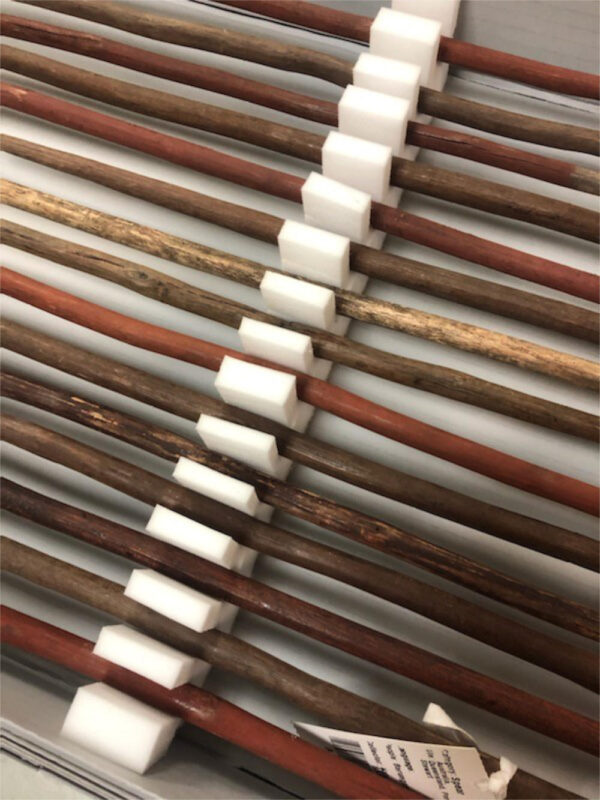
Image 21: Detail of the spear packing (using foam block spacers). Image courtesy of the South Australian Museum collections and Artlab.

Image 22: Detail of pigmented barb decoration. Image courtesy of the South Australian Museum collections and Artlab.
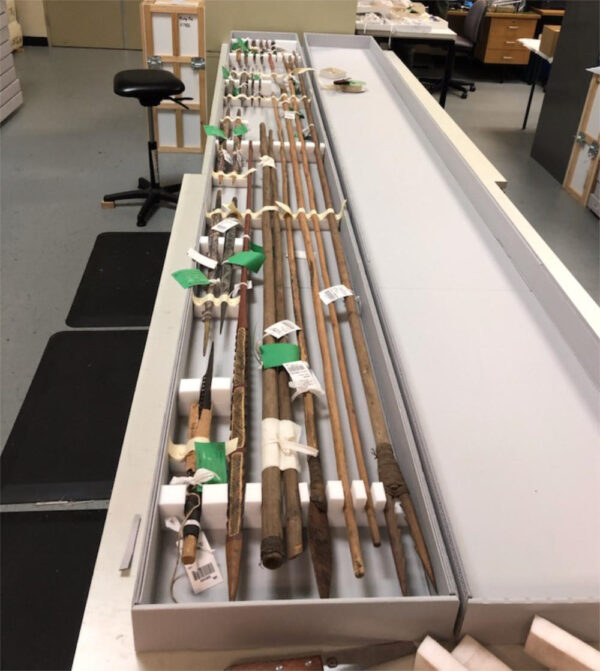
Image 23: A completed spear box pack. Image courtesy of the South Australian Museum collections and Artlab.
Paper & Books
National treasures reborn from the fire
Nine framed works were brought to Artlab after being salvaged from a house fire. The works consisted of six privately owned Hans Heysen watercolours, one by Albert Namatjira and two works by RW Sturgess.
All works were wet due to the firefighters’ intervention so immediate salvage work took place to stop the degradation process. The watercolours were brought into the paper lab, de-framed and dismounted from the matting boards using a disaster plan intervention that was completed in less than one hour and involved three conservators. The smoke and water damaged secondary materials were removed and stored in the quarantine fume hood to prevent volatile compounds affecting the air quality. The paintings were dried between felts to reduce the risk of mould growth or cockling.
After three weeks of drying under slight weight, the watercolours appeared in remarkably good condition due to the protection afforded by their framing and glazing. Consequently, the secondary materials—window mats, backing boards, frames and glass—took the full force of the heat, smoke and water, and in most cases suffered irreparable damage.
Where possible, all original secondary materials were reused and all provenance stamps, labels, and inscriptions were retained.
The conservation treatment was conducted by Aquila Evill, Senior Paper Conservator. The treatment focused on removing residual soot from the paintings and rehousing using the original secondary material where possible. Unfortunately, two of the original Heysen mounts with wash-lines could not be reused and were replaced with similar materials, replicating the hand-drawn wash-lines. Only three of the frames could be repaired.
The treatment procedure post-salvage was: surface clean (smoke sponge), humidify and flatten, re-mat using similar materials, draw wash-lines on two mats for Heysen works, rehouse three in original frames with UV filter glass. All the original material that could not be reused for framing such as damaged frames, backing boards and mats were kept and returned to the client.


Image 24 and 25: Before and after treatment. Into the Light, Hans Heysen, 1912.

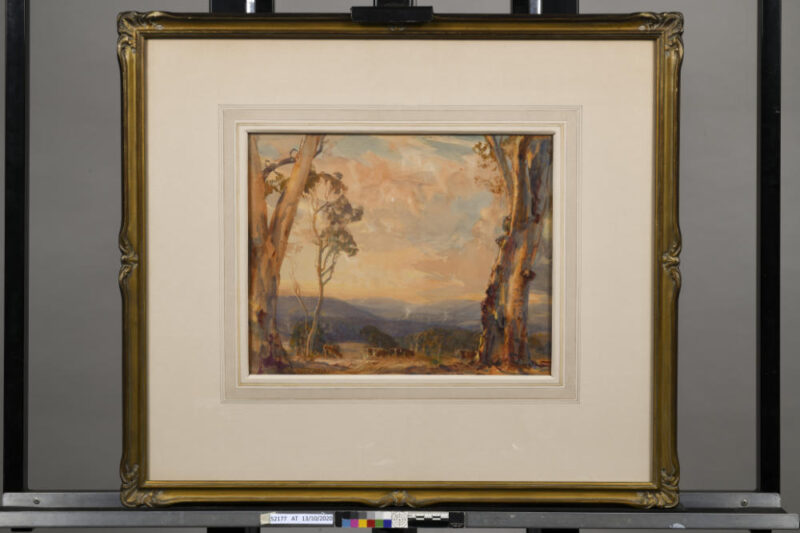
Image 26 and 27: Before and after treatment. Landscape with Gum Trees, Hans Heysen, 1912.
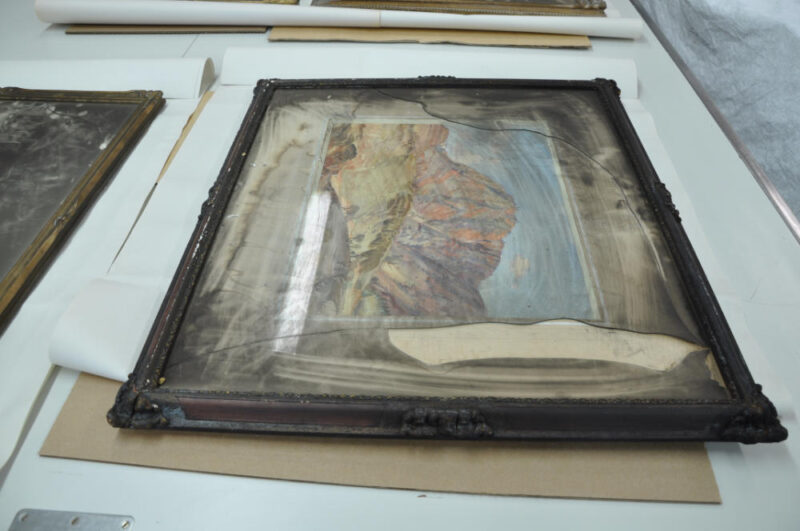
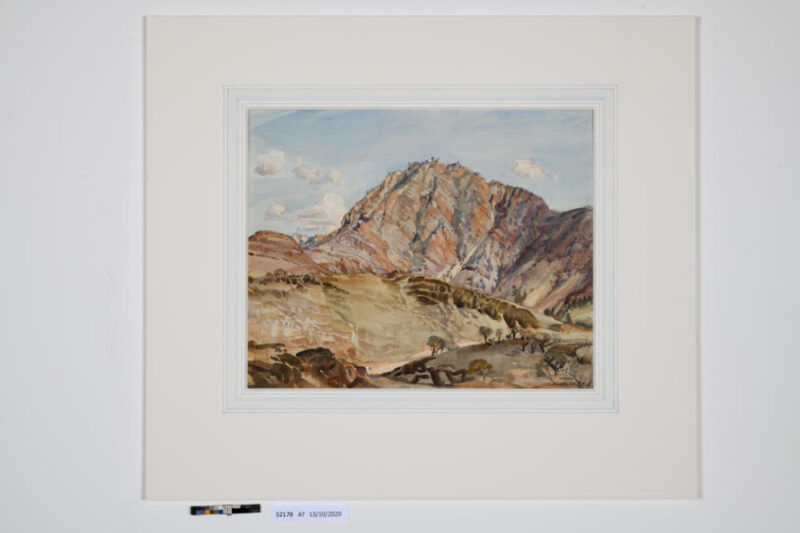
Image 28 and 29: Before and after treatment. The Gorge, Aroona, Hans Heysen, 1927.
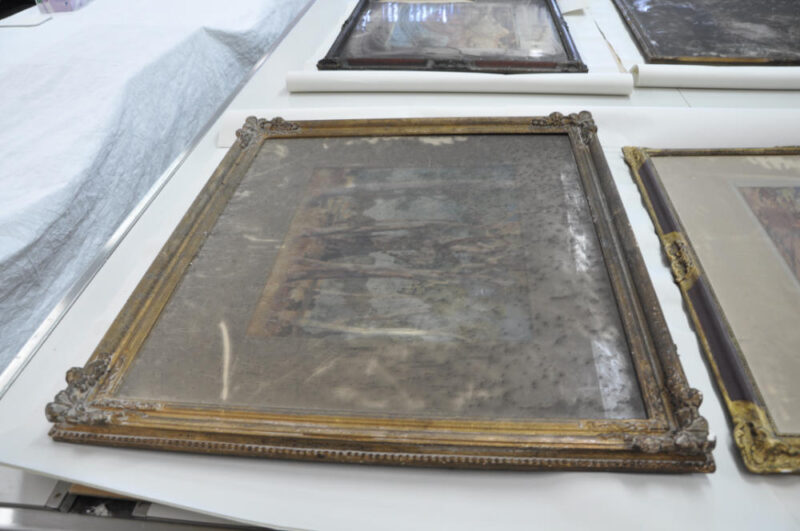
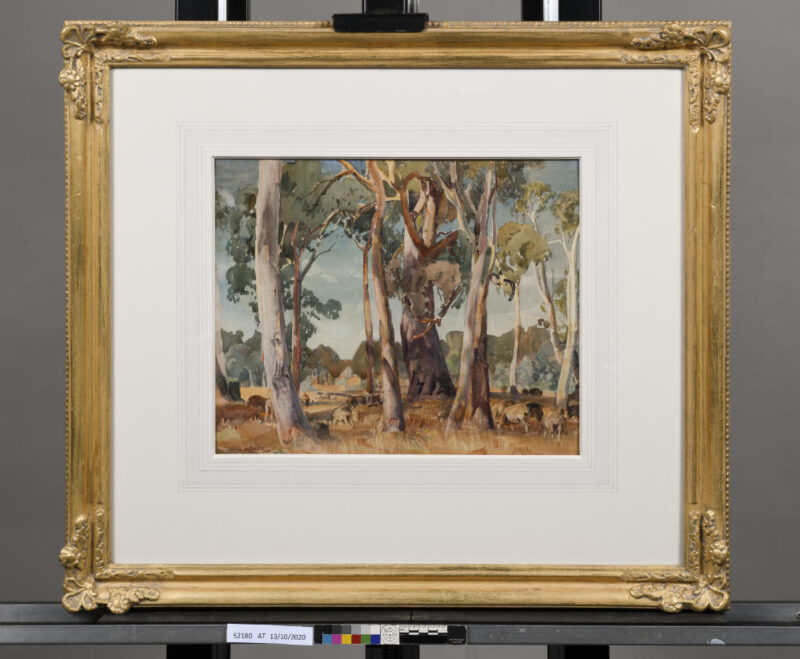
Image 30 and 31: Before and after treatment. Cattle under Gums, Hans Heysen, 1940.
Research projects
Heather Brown, Assistant Director, has recently been awarded a PhD with her thesis entitled:
Abstract: This research investigates the relationship between physical and digital preservation management in Australian national, state and territory libraries. It systematically investigates this relationship from the viewpoint of higher-level principles, then from the aspect of technical and administrative strategies, followed by a special focus on the strategy of disaster management. The results reveal that, in contrast to the widely held view that ‘digital is different’, there are significant interconnections between the two domains. The interconnections include higher-level principles as well as a number of strategies, while noting barriers and areas of disconnect such as the specialist knowledge and skills in each domain. The findings encourage new ways of thinking about digital and physical preservation management, leading to opportunities to link the two domains and to share knowledge.
Roberto Padoan and a number of distinguished international colleagues have recently published an article about monitoring changes occurring in paper artefacts during exhibitions. This study focuses on assessing impact and reproducibility of imaging spectroscopy as a monitoring tool.

Image 32: The imaging spectroscopy instrument SEPIA at the conservation lab of the Nationaal Archief, National Archives of The Netherlands, Den Haag, The Netherlands.
Abstract: Ageing of historical documents often results in changes in the optical properties of the constituent materials. Imaging spectroscopy (IS) can be a valuable tool for monitoring of such changes, if the method fulfils two important conditions. Firstly, compared to natural ageing, the accumulated light dose from repeated measurements of the monitored document must not induce any significant degradation. Secondly, the monitoring instrumentation and procedures should be sensitive enough to detect changes in the materials before they become visible. We present experimental methods to evaluate the suitability of IS instrumentation for monitoring purposes. In the first set of experiments, the impact of repeated monitoring measurements was determined using a set of Blue Wool Standard materials. In the second set of experiments, the capability of the instrument to detect spectral changes was tested using ISO standard materials and several documents representative of European archive collections. It is concluded that the tested hyperspectral instrument is suitable for monitoring of the colour change of documents during display. The described experimental approach can be recommended to test the suitability of other imaging spectroscopy instruments for monitoring applications.
Tasmania
Tasmanian Museum and Art Gallery
Objects Conservator Nikki King Smith is working with David Thurrowgood to build two anoxic showcases for the thylacine on permanent display at TMAG.
Funding was successfully found through the generous support of the Friends of TMAG and as a way of saying thank you to the Friends, David was able to give an exclusive look at what it takes to build an anoxic case, and explain its significance in terms of damage control for our most valued thylacine.
Paper Conservator Cobus van Breda continues working on Paradise Lost, an exhibition about the mysterious Thomas Griffiths Wainewright, opening in June.
Just recently the TMAG made improvements to the Customs House building. This included fixing floorboards, painting the walls and generally making it meet the building codes (in an alarming discovery, cardboard had been used to replace some lost floorboards). Now that the corridors are looking plush, Jenny O’Connell and Lisa Charleston are preparing to hang 18 landscape paintings from the TMAG collection in clusters on the first floor. Cleaning, glazing and refitting the paintings will ensure the hang is presentable and the paintings are safe.
Aside from back-to-back exhibition installs and deinstalls, including David Keeling’s Stranger, Lisa Charleston is preparing material for Paradise Lost. Another highlight in the new year has been participating in TMAG’s First People’s Roadmap Working Group, which assisted in delivering an unreserved Apology to the Aboriginal people of Tasmania on 15 February.
Libraries Tasmania
Current projects
The conservation lab has been very busy with many requests for assistance with access to fragile material for archival and heritage items from our collections. We have been continuing to rehouse the Allport collection of artworks with friable media and the Mercury newspaper photographic negative collection. Gaynor Tollard, Conservation Officer, has been making more special boxes for objects coming into the archives such as this 1849 promissory note from a founding businessman of the Bank of van Diemen’s Land.
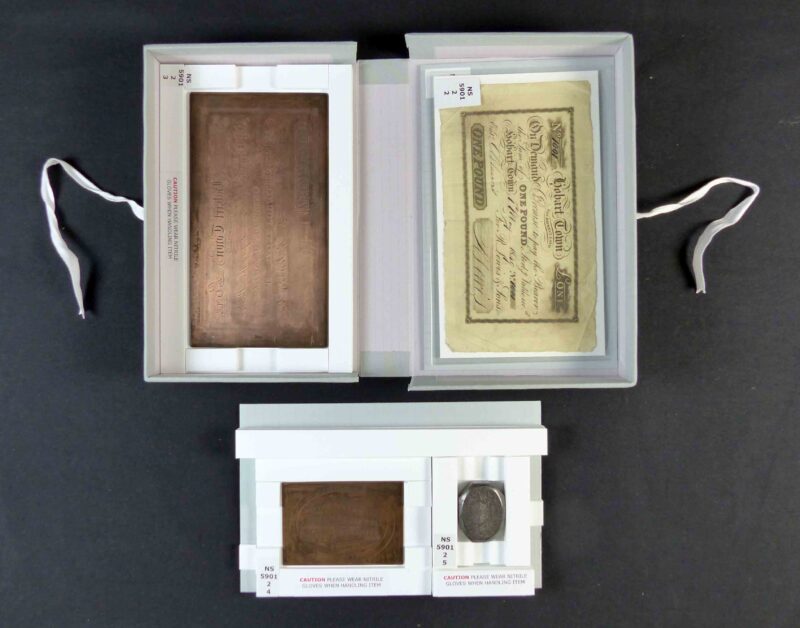

Above: Custom box for NS5901/1/2–5 promissory note, printing plates and block stamp.
Julie Kaja, Library Technician, has also ventured into the world of custom boxes and made a box for an 1878 sample of tin from the Marie Louise tin mine in north-eastern Tasmania.

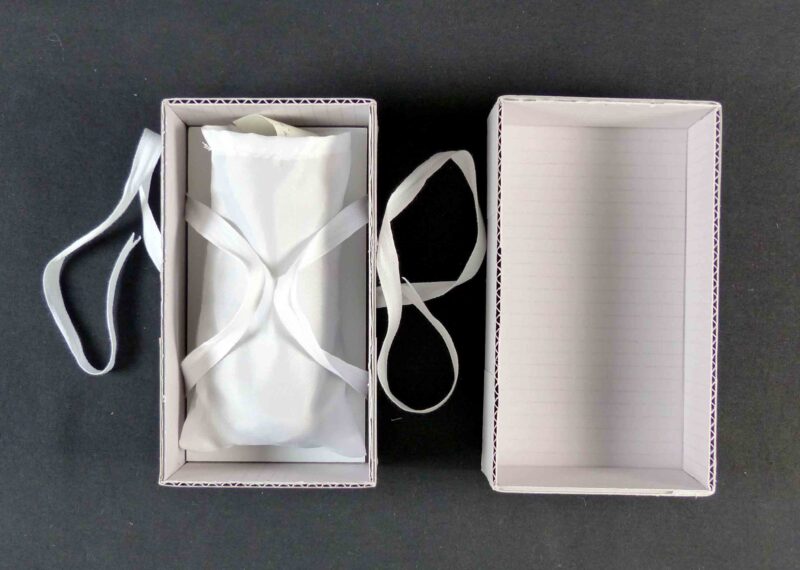

Above: Custom box for CRO 669.6 SAM sample of tin from the Marie Louise Mine.
Stephanie McDonald treated a 1912 plan from a gold mining report, which was needed for digitisation and could not be opened flat for photographing.


Above: Plan treated for pressure-sensitive tape removal, repair and lining TLP 622.3421 TAS.
Exhibitions
We are about to change over exhibitions in the Allport Gallery and will be de-installing the Under your nose exhibition consisting of reproduced images from our collections to support Movember.
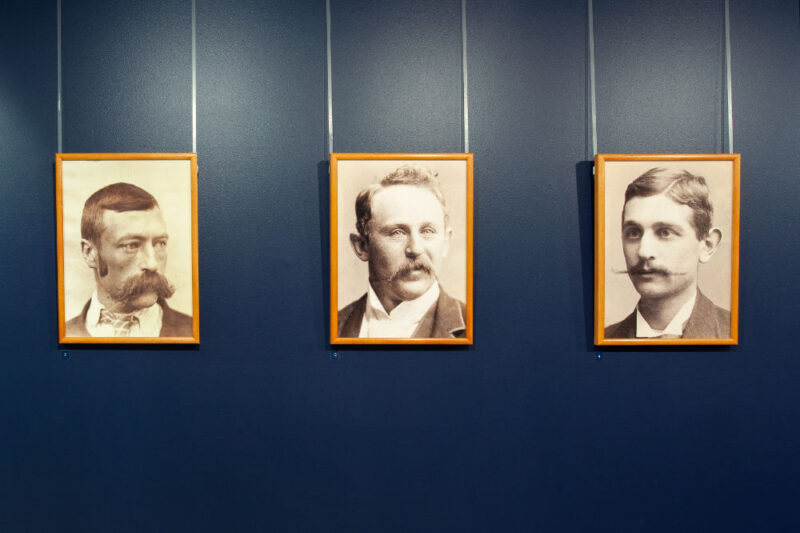
Above: Under your nose exhibition in the Allport Gallery
Victoria
ACMI
Registration
ACMI’s Registration, Exhibition Production and Collection teams have worked tirelessly to bring ACMI’s Story of the Moving Image (SOMI) and new exhibition spaces to life after a two-year closure at Federation Square (Melbourne). ACMI’s renewal project has seen the opening of the purpose-built, glass-fronted Blackmagic Design Media Preservation Lab (MPL) where visitors can view the conservation of collection artefacts and time-based media (TBM) as well as film digitisation as it is conducted.
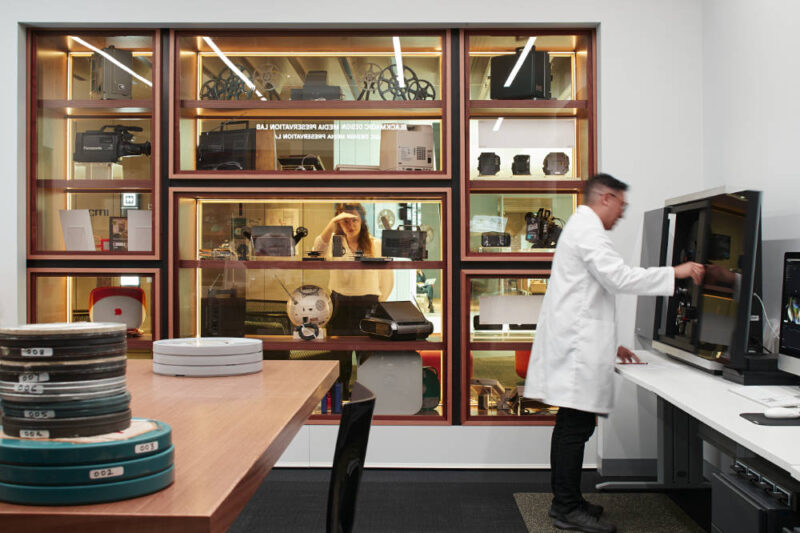
Above: Blackmagic Design Media Preservation Lab, inside. Photo by Shannon McGrath.
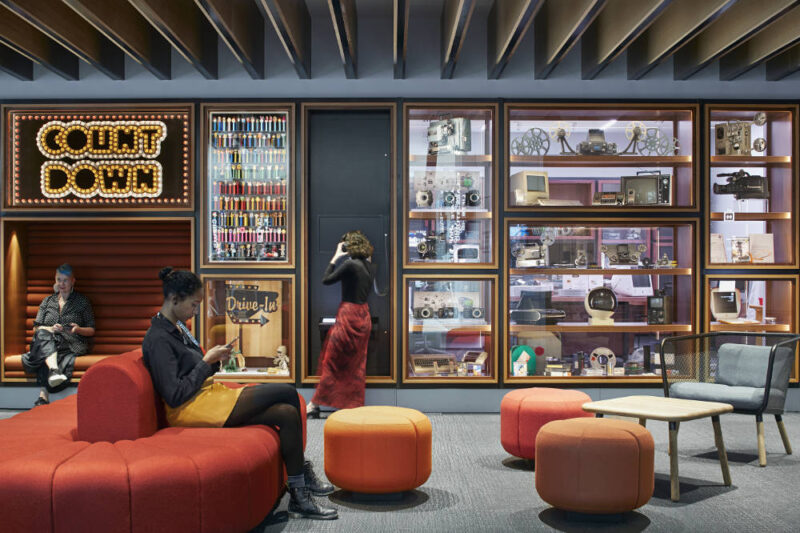
Above: Blackmagic Design Media Preservation Lab, outside. Photo by Shannon McGrath.
ACMI’s Registrar Sarah Caldwell has guided her team of Fiona Mowat, Holly Robbins and Megan Taylor through the installation of over 1000 artefacts (costumes, film and TV equipment, film paraphernalia and moving-image pieces), 28 loans and 66 collection objects (not seen by the public before). Preparation of these artefacts would not have been possible without the aid of Objects Conservation Melbourne, International Conservation Services, c/o Studios, Marion Parker and Penny Byrne – a huge thanks to all. ACMI’s Registration team has also collaboratively rolled out passive conservation supplies and ACMI-developed environmental data-logging equipment in SOMI exhibition cases. This marks the start of a new passive style of object display preservation for ACMI Exhibitions and our stakeholders and will provide us with a valuable source for experimentation and study.
Collections
Time-based Media Conservator Candice Cranmer has worked closely with Lucy Willet (Exhibition Production) and Glenn Willey (Exhibitions AV) to document all new acquisitive commissions to ACMI, which sees a significant increase (63%) in complex TBM acquisitions on any other year. Some of these complex works include Yanmeeyarr by Vicki Couzens, Canopy by John Harvey, CATARACT (concrete) by Daniel von Sturmer, The Silenced by Julie Gogh and new software-based interactives.
Preservation work also continues on the Cyberthon archive of 1990s rave culture moving image works/events. Head of Collections and Preservation Nick Richardson leads our collaborative work on videogame preservation with Melanie Swalwell and Swinburne University (ARC Play It Again) and Cynde Moya, formerly the manager of the Software Preservation Lab at the Living Computer Museum in Seattle, also joins the ARC team as a chief investigator. In tandem, our collaboration in the Media Arts ARC grant sees the deposit of the Experimenta Collection to ACMI (a 34-year-old collection of highly significant Australian media artworks) which we are also preserving collaboratively.
The Collection team welcomes Mar Cruz who joins Ben Abbott as a Digital Preservation Technician in the MPL. Both will work across the preservation of ACMI’s film, videogame and TBM collections. In addition, the soon-to-be-appointed Grimwade and ACMI Time-Based Media Conservation Fellow will also base themselves in the MPL to undertake a research project and implement innovative preservation strategies for our TBM collection.
Grimwade Centre for Cultural Materials Conservation and Grimwade Conservation Services, the University of Melbourne
Academic programs: teaching and research
Like other conservation institutions in Melbourne, the Grimwade Centre had to be very flexible and open-minded in 2020. We learnt a lot during the two lockdowns and our staff, students and researchers all became quite resilient and accepting of our doors opening and shutting, our online teaching and the safe protocols. Our students were so committed and although we are still wearing face masks in the laboratory, everyone is happy to be back at the Grimwade Centre with our catch-up practical boot camps before the semester starts.
There was plenty to celebrate in 2020 too. Well done to the graduates of the master’s program: Caitlin Knight, Laila Nurul Fitrani, Denise Maree Flanagan, Bella Matilda Lipson-Smith, Lisa Anne Mansfield, Emma Grace Lewis Morrison, John David Morrison, Amalia Ranisau, Louella Winifred Raynolds, Sandra Song, Isabella Hindley Walker and Sandra Lorelle Yee. Many institutions continued to support our master’s students’ research and internship placements during difficult times including Artlab Australia, Arts Centre Melbourne, Australian War Memorial, the Berndt Museum of Anthropology at the University of Western Australia, Buxton Contemporary, Grimwade Conservation Services, International Conservation Services, Library and Archives NT, National Gallery of Australia, Ochre Imprints, and Warrnambool Art Gallery. Thank you very much to the staff at these institutions who made this possible. Special acknowledgements to Lisa Mansfield for the award of Student Conservator of the Year (thank you ADFAS for supporting this), and to Laila Nurul Fitrani for the Alexander Copland Award for the best minor thesis, entitled Identifying unsaturated polyester resin in Indonesian artists’ material.
Congratulations are also due to Dr Evan Tindal, whose PhD thesis 3D-printing in art: Material susceptibility and strategies for long-term preservation is fully conferred and examined. Any 3D-print ageing questions can now be referred to Evan – he knows! Two more PhD theses were recently submitted and include:
- Leila Allagh’s Interdisciplinarity approaches to the study of distanciated (Islamic) manuscripts: ‘Sad Kalamih Shah Vilayat (One Hundred Sayings by Ali): Manzumih dar Hajj (Futuh al-Haramayn)’ – a case study
- Sophie Lewincamp’s Tiered Contact Zones: A new engagement model for cultural materials conservation.
Three PhD students are at the commencement end of their theses, with:
- Heather Berry assessing treatment methodologies for Australia’s maritime heritage, a project supported by a stipend from Silent World.
- Seka Binaramali Seneviratne’s Conservation treatments: biodeterioration methodologies and their effect on paint films
- Hohi Ikeda’s Hidden treasure: using new technologies for visualising and rediscovering the lost art of Keith Haring.
Post-graduation student highlights
- Juanita Kelly-Mundine was recently appointed to work with Terri Janke and Associates on issues of cultural heritage preservation.
- Gadis Futriani Putri is joining the NICAS X Rijksmuseum as Research Associate for 12 months. Her position is supported by the Andrew W Mellon Foundation.
- The Grimwade and ACMI Time-based Media Conservation Fellowship was launched. Working between ACMI’s Media Preservation Lab, and Grimwade Conservation Services in North Melbourne, and supported by Chancellery, Grimwade Centre and Australian Centre for the Moving Image, the recipient will develop specialist knowledge and contribute to cutting-edge work at ACMI and Grimwade.
- Saiful Bakhri, Indonesian alumnus, was awarded the University of Melbourne Alumni Rising Star Award. Saiful is currently working with Dr Nicole Tse providing Grimwade students with internship opportunities with Indonesian organisations.
Grimwade Centre Visiting Scholar
This year the Grimwade Centre for Cultural Materials Conservation at the University of Melbourne has been fortunate to have Mr Kencho Dekar as our Grimwade Centre Visiting Scholar. Kencho is a master traditional dye-maker from Bhutan who has revived traditional Bhutanese dye-making practices. He is the only person in Bhutan engaged fulltime in the process of the tradition of natural dyeing as an art and as an ecologically sound and sustainable activity.
Kencho was trained by his father, who started the National Handloom Development Project (NHDP), as well as completing his own studies. Kencho has taught into the Grimwade Master’s Program in Cultural Materials Conservation for the past three years. He has recently published a book on traditional dye-making in Bhutan, which has been sponsored for use in schools in Bhutan by the Bhutanese Prime Minister. Unfortunately, due to COVID, Kencho has been unable to travel to Australia; however, he will be presenting workshops with students online, as well as presenting a number of public events. Stay tuned for details.
Grant successes
- The Technical Study of Bernini’s Bronzes: Art History, Conservation, and Materials Science. Dr Jonathan Kemp and Professor Evonne Levy from the Department of Visual Studies at University of Toronto will undertake comparative analysis of Bernini’s works in bronze. This project is supported by the Melbourne–Toronto Joint Research Program.
- Watatoor Grinding Stones exhibition on the ground floor of Arts West, the University of Melbourne. Professor Robyn Sloggett and Dr Vicki Couzens (Gunditjmara Keerray Woorroong) received a City of Melbourne grant for this exhibition, which uses stone tool material from the university’s Leonhard Adam Collection and is now being expanded to produce an audio soundscape to fill the space with Gunditjmara language relating to the exhibition.
- 3D printing of custom musical instruments for heritage and industry needs. Dr Nicole Tse is now working on this Australian Research Council Linkage Project with Professor Aaron Corn, Professor Jon McCormack, Professor John Carty, Dr Jing Fu, Dr Gea Parikesit, Dr William Robertson, Dr Anthea Skinner and Mr Wukun Wanambi. Nicole’s main focus will be on the digitisation and printing of musical instruments from the MAMU (Music Archive Monash University) collection.
New equipment
Staff and students at the Grimwade Centre await the delivery of the Er:YAG/Nd:YAG conservation laser with much excitement. Laser cleaning has become a standard for most major conservation laboratories for the cleaning of artworks. Since the 1970s these have been of one type, the Nd:YAG (neodymium-doped yttrium aluminium garnet) laser, similar to a tattoo-removal laser, which in effect works on colour contrast to self-limit its actions as it ‘ablates’ darker-coloured stains and accretions from objects made from things like stone or wood. Very recently there has been an upsurge in the use of a different type of laser, Er:YAG (erbium-doped yttrium aluminium garnet), similar to what in the cosmetic surgery industry is called a ‘skin planer’ and which has proved extremely useful for removing layers of similar-coloured materials such as with overpaints and varnishes. The unit, supported by the Miegunyah Fund, is the next step in laser technology, with both types of laser being incorporated in one portable unit by UK supplier Lynton Lasers. The Grimwade Centre will be the fourth such equipped facility in the Australia–Pacific region—colleagues at the University of Canberra, the Art Gallery of NSW and the National Museum of Tokyo received the same unit in late 2020—offering the region a research cluster to explore the technology’s potential use to help preserve aspects of its unique and diverse heritage. Build completion is scheduled for the end of February 2021—assuming COVID-19 does not cause delays—after which it will be shipped to the Centre with subsequent online training to staff and students provided by conservation laser expert Dr Martin Cooper.
Commercial services
Paper Conservation Lab
After an epic three-year treatment, the Paper Lab dispatched two amazing 17th-century Dutch wall maps to be part of the reopening of MONA. An essay by Peter Mitchelson, Christine Mizzi and Lois Waters accompanying the catalogue of works by Georgiana Houghton belonging to the Victorian Spiritualists’ Union was published late last year. The significance of Georgiana’s works has only recently been internationally acknowledged. Peter, Christine and Lois discuss the conservation implications of her materials and processes.
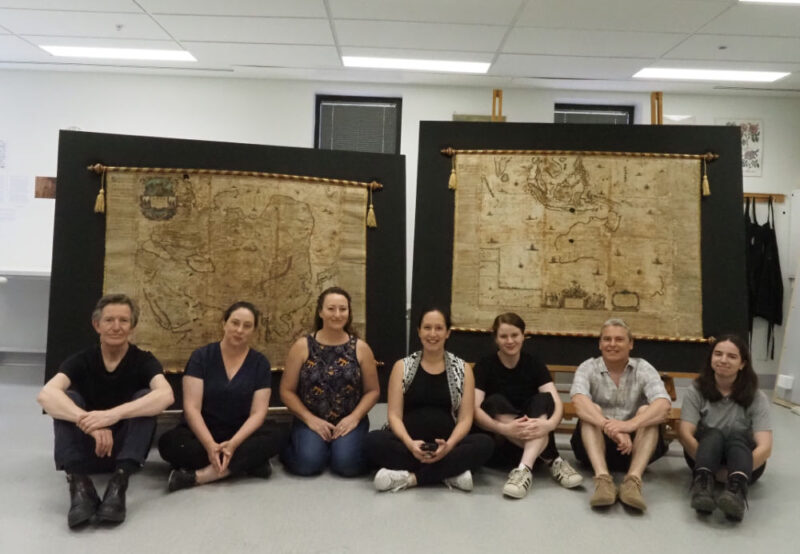
Above: Paper team.
There have been some personnel changes to the team in the Paper Lab as Noni Zachri started her maternity leave at the end of 2020 and gave birth to Maya Zachri-Little on Monday 1 February 2021. To fulfil Noni’s role in her absence, we welcome Camielle Fitzmaurice who joins us from the National Library of Australia. Camielle is already familiar with GCS, having completed her internship with us some years ago.
Paintings Conservation Lab
The Paintings Conservation team has commenced the year with a full work program. The team is working on a large institutional collection that was water damaged in late 2019. Treatment of the collection commenced in 2020, but its completion was slowed due to limited access to the labs through the year. The team is now finalising the treatment of the collection for return to the client.
Paintings conservator Caroline Fry has been treating the Portrait of Sir Redmond Barry by George Folingsby. The painting was commissioned posthumously by the University of Melbourne to commemorate Sir Redmond Barry (1813–80) as the university’s inaugural chancellor . Originally, the painting was a full-length portrait, but both painting and frame were extensively damaged in the Wilson Hall fire in 1952. In 1969, the remains of the picture were cut down and marouflaged to a Masonite support at the NGV under David Lawrence. It was reframed and has remained in this format since that time. The current treatment requires removal of a thick discoloured layer of varnish and old retouchings. Research has uncovered much about the vicissitudes of the portrait over time.
Caroline also presented two on-line seminars in late 2020 to M Arch Conservation students at the School of Planning and Architecture, Bhopal, India, and to the Space A6 science community in St Petersburg, Russia, on the science of paintings conservation.
Objects and Textiles Conservation Lab
The Objects Conservation team has been busy with many off-site projects over the last three months. These include the repair of original linoleum in the University of Melbourne’s 1888 building, cleaning bronze honour boards in Bendigo, completing and installing archaeological objects at Charter Hall, and surveying the Savory and Moore pharmacy at the Brownless Medical Museum. The pharmacy features furniture, fittings and pharmaceutical supplies that date from 1849 to 1868 and include pharmaceutical products from our namesake Grimwade of Felton, Grimwade and Duerdins Ltd.
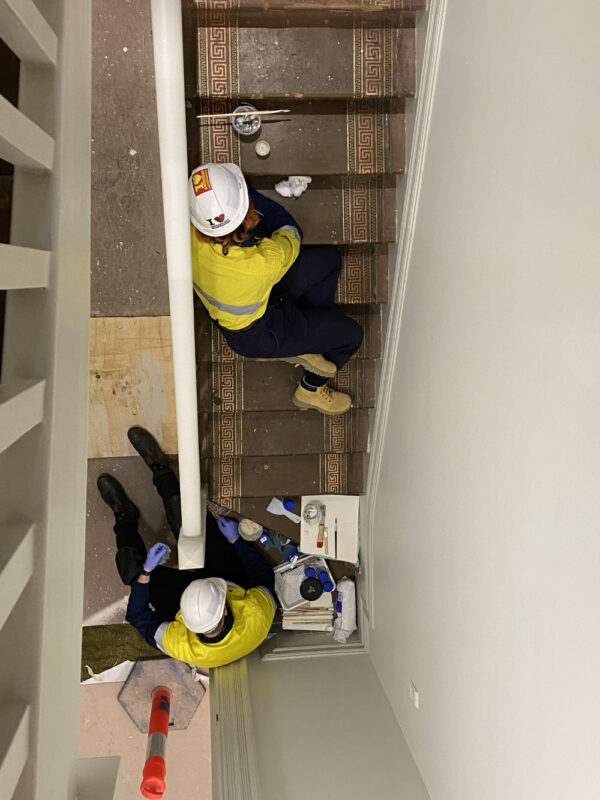
Above: The University of Melbourne’s 1888 building.
In the lab we have been completing a large ceramics conservation project, archaeological conservation, de-restoring and conserving a marble fountain and conserving bespoke chromed furniture made for Heide Museum of Modern Art founders John and Sunday Reed’s home.
A large conservation project with the Tatura Historical Society, funded by a Heritage Victoria living heritage grant, was completed by conservators from all labs. Victoria Thomas treated a collection of puppets and travelled with Peter Mitchelson to return and present the puppets.
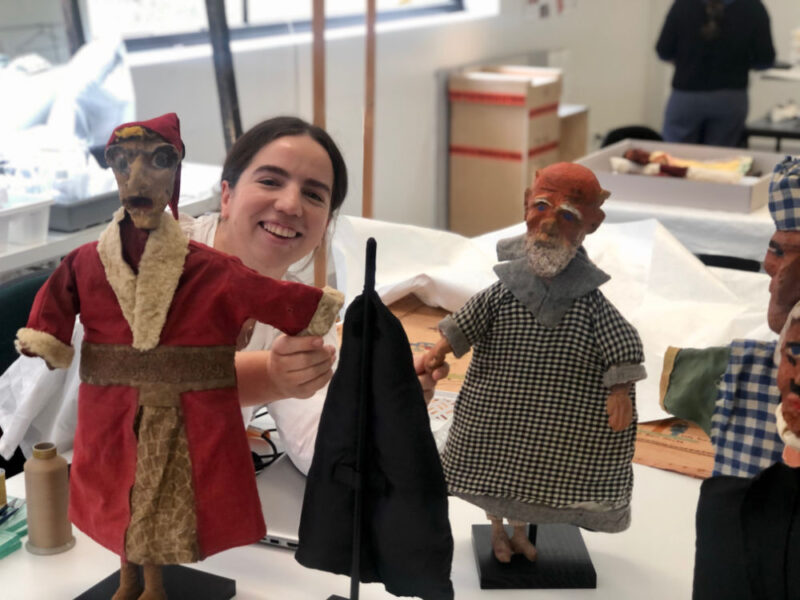
Above: Victoria Thomas and puppets.
We recently farewelled two team members, Victoria Thomas to Artlab Australia and Emma Hayles to the Powerhouse Museum, and will welcome Lisa Yeats in early March.
ICS Melbourne
In December 2020 we bid farewell to Fran Paterson, Senior Conservation Manager for our Melbourne lab. Fran worked with ICS in Sydney as a trusted Conservation Projects Manager in the Objects & Outdoor Heritage Team for some years before moving to Melbourne with her family. She supported the formation of our Melbourne team at a critical time, and we will miss her thoughtful approach to team management and her contributions to the company.
Katie Smith is our new Conservation Manager in Melbourne. Katie joined the team in February after completing a BA (Hons) in Conservation at the City & Guilds of London Art School, specialising in stone, wood and decorative surfaces. Prior to that Katie ran her own antiques business for some years. We very much look forward to working with Katie to build the Melbourne business after a year of COVID lockdowns.
National Gallery of Victoria (NGV)
General
Following the Victorian state government announcement supporting the build of NGV Contemporary, Michael Varcoe-Cocks, Associate Director, Conservation, will be a key member of the NGV planning committee, with support from Jessica Lehmann, Conservation Project Officer. As part of the earliest tasks of the group, Michael has been attending meetings with government stakeholders, informing the project scope and scheduling, and assisting with the NGV-C design competition. The new gallery will be located adjacent to the NGV-I site and comparable to Tate Modern in size (approx. 30,000 m2 with one third dedicated to gallery space). The successful design team is expected to be announced in summer 2021/22.
Coordinating Conservator MaryJo Lelyveld has been coordinating conservation activities towards the opening and maintenance of NGV Triennial (19 December 2020 – 18 April 2021) including exhibition risk assessment and review, and contributing towards the Centre for Frame Research and other departmental activities.
Jessica has been managing social media and outreach programs including the upcoming online course: Colour, NGV Magazine (look out for an extensive essay on Australian Impressionism treatments in the March/April edition and Lighting Conservation from neons to historic lamps in the Jan/Feb edition), as well as regular stories and posts on @ngvmelbourne Instagram (recently there has been a wheat starch post, a TIWI mount-making post and a Q&A story with conservators for ‘International Day of Women and Girls in Science’) as well as a new self-guided ‘Secret Life of Art’ tour using special labels to guide our visitors through our collection at NGVA, which will be installed and online in March 2021. Jessica has also been contributing to the preventive conservation program, Centre for Frame Research and administrative duties across the department.
Fashion and Textiles
The fashion and textiles team has started settling into its new normal, which at the moment looks a lot like the old normal, consisting of a rather long photography schedule and a long list of changeovers, requests, and big treatments. Di Knight joined us again for a short-term contract as of 15 February, when the team embarked on the large-scale treatment of the Murdoch Jacobean crewelwork curtains. The curtains were bought as a wedding gift for the Murdoch’s and hung at Cruden Farm for many years. While time has not been kind to the backing cloth, the embroidery itself, which consists of a tree-of-life design, is stunning.
We eagerly await the next delivery of pieces from Kerry Taylor Auctions, with palpable excitement for a 1920s embroidered kimono going into our Asian collection and a 2011 Galliano for Dior ballgown with some truly inspiring colour graduation from pink to black – wow!
We will also continue to explore the forgotten treasures of the collection as we condition assess our entire F&T collection – a reporting project that we began during October/November 2020. From what we have found already we are convinced we need to stage a fancy dress exhibition, an underwear exhibition and perhaps even a 1950s ballgown exhibition.
Paintings
Up until February’s brief lockdown in Victoria the painting conservation studio was engaged in picking up a lot of unfinished business from 2020, namely completing conservation treatments, processing a backlog of new acquisitions, and planning for the year ahead. Painting Conservator Caitlin Breare completed her work on Thomas Clark’s Falls on the Wannon, Senior Painting Conservator Carl Villis completed Mary Beale’s portrait of her son Bartholomew, Painting Conservator Raye Collins continued varnish removal of Constance Stokes’ Portrait of a Woman in a Green Dress, and Painting Conservator Raymonda Rajkowski completed consolidation and structural repair on Edward Middleditch’s Summer Landscape. Raye and Raymonda, co-convenors for the AICCM Paintings SIG, have been discussing options for the upcoming Paintings SIG symposium, which was due to be held in Melbourne this year. Caitlin has been active in two of the NGV Conservation department working groups: Procedures and Preventive. Caitlin and Raymonda have also contributed to an advisory planning group for NGV-C . Carl has been investigating and assessing new X-ray systems to eventually replace the department’s 20-year-old unit.
Objects
Aside from regular Triennial maintenance we are already turning our heads to the planning of the deinstallation of some of the Triennial projects in mid-April. Some exciting exhibitions are on the horizon that will see us very busy over the rest of the year with preparations for Big Weather and History in the Making currently in full swing.
Frames and Furniture
It’s been a busy few months working back on-site with the Triennial install, documentation, maintenance and deinstall planning being major areas of focus. We are now working on pieces for upcoming exhibitions and permanent collection changeovers. In addition, the team and other colleagues in the department have been developing content for the NGV Centre for Frame Research microsite, soon to be launched on the NGV’s website. Frame maker Jason King has been making reproduction frames for two works in the forthcoming Australian Impressionism exhibition, including the key work Sheoak and sunlight by Tom Roberts (1899). Frames and Furniture Conservator Suzi Shaw has been condition checking a large number of 20th-century international furniture new acquisitions and preparing them for display and has also contributed to the Procedures and Preventive working groups. Senior Frames and Furniture Conservator Holly McGowan-Jackson has written and recorded essays for the NGV’s new online course: Colour.
Exhibitions
Mid last year we packed up hundreds of international loans for return and experienced our first live-stream pack-up cross to New York (over five hrs!). Exhibitions have continued to be mounted with Senior Exhibitions Conservator Catherine Earley braving the ‘ring of steel’ on several occasions, armed with paperwork and food/drink, to condition report works for the Ivan Durrant show. As pressure grows around couriers, border closures and quarantining she is currently developing live-stream condition reporting methods. Exhibitions Conservator Janelle Borig is also grappling with organising condition reporting of Australian Impressionism loans from a distance, possibly the theme for 2021.
Since the new year Catherine has been condition reporting Japanese lacquer, including multi-part miniature games, to accompany a 720-piece pick-up-two game constructed of gilded clam shells painted with Australian flowers. Beautiful, but months to go! While she is also in planning mode for our next Melbourne Winter Masterpieces exhibition, Janelle is multi-tasking on the TIWI deinstallation and the fast-approaching Australian Impressionism and Top Arts shows.
Paper and Photography
Since our return to working on-site the Paper and Photograph team has assisted in the preparation and installation of Triennial pieces in fields quite unfamiliar but interesting to us, (i.e. tying feather flowers to netting, stitching Velcro to large tapestries.) With this exhibition now open to the public, we have been addressing the year’s acquisitions that continued to arrive and were put in a state of temporary holding. We also saw the return of two important artworks from Japan that had been part of a four-year Japanese restoration project by the National Institute of Cultural Property, Tokyo. They look magnificent following the project and the care taken to preserve them has been extraordinary.
Like other teams within the department, we have contributed to the NGV’s forthcoming online course: Colour, covering the watercolours used by William Blake, Japanese Aizuri-e prints, colour assembly process of two photographers from the late 1930s early 1940s and pigment use in Indian miniature painting.
State Library of Victoria
Since our last news from the State Library of Victoria, we have been principally occupied by the uncertainty around COVID-19. All Collection Care staff continued to work from home during the second lockdown from July to November 2020. I won’t mention our most, recent five-day lockdown, as it passed in a flash!
Recent highlights were the arrival of a baby boy, Karlo, to Jess McElhinney, who is now on parental leave, trading places with Albertine Hamilton, who has returned to work after a year’s leave following the birth her boy, August. We can also confirm we have appointed Bonnie Hearn as our new book conservator. Bonnie has settled into her new role and our experienced book conservators Katrina Ben, Ian Cox and Helen McPherson have much to pass on.
Our Preservation Technician Emily Keppel was successful in her application to fill a contract paper conservator position in the Conservation team, covering a temporary staffing shortfall. We welcome Emily to her new role and have lots in store for her working with the Paper team. Our Preservation team is currently searching for a short-term replacement to fill the role Emily has left.
Registration and Loans
It would probably be a familiar experience for all that our exhibitions program has had to be revised more than a few times responding to COVID-related shutdowns and COVID-safe social distancing requirements. Now back on-site our registrars Sarah Haselton and Fiona Wilson are able to begin managing the assessment of outward loan requests that came in during lockdown and to dispatch loans that were put on hold throughout this period.
Since November we have dispatched loans to the Old Treasury Building for the Yarra exhibition and to AGSA for the Clarice Beckett: The Present Moment exhibition. We will soon dispatch loans to Post Office Gallery Bendigo for Modern Revolution: Bendigo and the 1960’s, to the Parliamentary Library, Parliament House and to the NGV for the exhibition She-oak and sunlight: Australian Impressionism.
Eighty-two loans that were extended during lockdown, from private and institutional lenders, featuring in the Velvet, Iron, Ashes premier exhibition in Victoria Gallery were returned to nine lenders in November and December.
In February work has commenced on securing loans for the second major exhibition to be staged in the Victoria Gallery in 2022 and for the World of the Book exhibition in the Dome Galleries, June 2021.
Preservation Team
The Preservation team members have had their heads down during the COVID lockdowns updating disaster response procedures, creating manuals and guidelines for treatments and work programs, in addition to responding to a range of essential issues across the site, including assessment and restocking of disaster materials and equipment in our Disaster Store. The extended lockdown has resulted in backlogs in quarantine, processing new acquisitions and the preparation of Victorian newspapers for the externally funded digitisation programs. A significant number of collection offers have been held over during COVID, which has necessitated a greater than usual number of off-site assessments of collections.
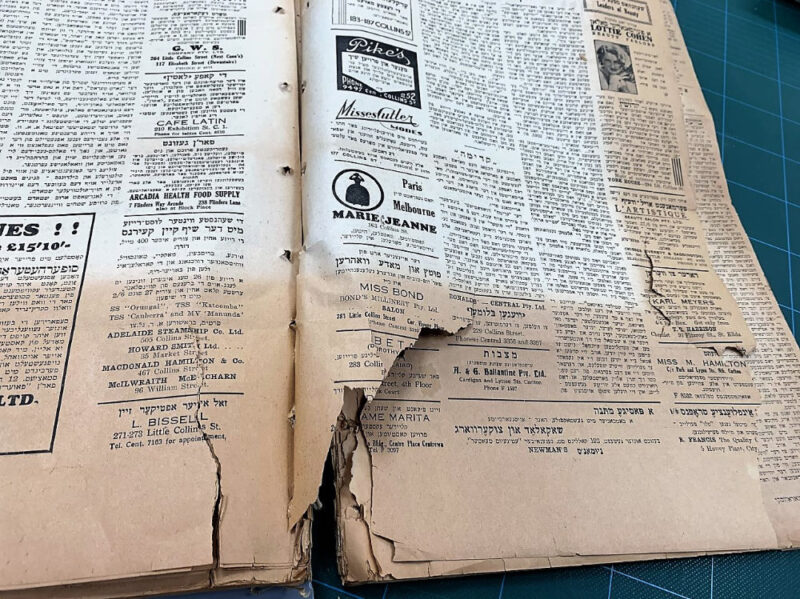
Above: ‘Oystralier leben’ (‘Australian Life’) Newspaper preparation.
A major piece of work started by Kate Holloway involves the identification of hazards in our collections. A comprehensive record of hazardous materials (substances and objects) and related fact sheets has been created and, now that we’re back on-site, collection surveys and a register of our hazardous materials will follow.
Needless to say, it’s been lovely being back working with our collections, and once again balancing the need for accessibility with long-term preservation. Discussions on the best support structures for silk-lined shoes and the importance of identifying Indigenous content in legacy collections together with nutting out the best ways to store a myriad of objects are just a sample of how we’ve been spending our time.
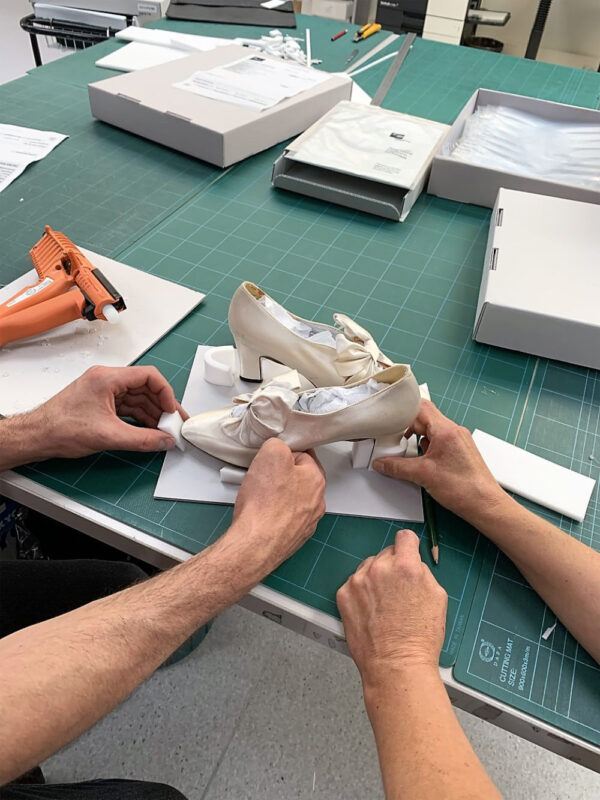
Above: Vali Myers Collection (uncatalogued) custom boxing of shoes preparation.
Conservation Team
Similarly, with Conservation, we have all breathed a collective sigh of relief to arrive back at the bench. It’s been a bonus to have had so much online training and world-class conferences at our fingertips, despite the global time differences, leading to odd hours of attendance.
Exhibitions work included an overdue deinstallation of our World of the Book exhibition, which is usually a major changeover effort. The Dome exhibitions are currently not open to the public due to lift access and social distancing. As a result, the reopening of this exhibition is scheduled for later in 2021 for which preparation of new material is now underway, including a new section on the books of William Blake.
Procedures in handling mould-affected material have been revised and implemented by Marika Kocsis and Helen McPherson to ensure staff health isn’t compromised and collection material is made safe to handle.
Katy Glen and Marika Kocsis made the most of a batch of precious Jun Funori, consolidating the fragile areas of a pastel portrait by Sybil Craig and some works by William Barak. Airbrush application of the consolidant across the pastel and charcoal surface of a portrait of stained glass artist William Montgomery has successfully facilitated the repair of the severely degraded support.
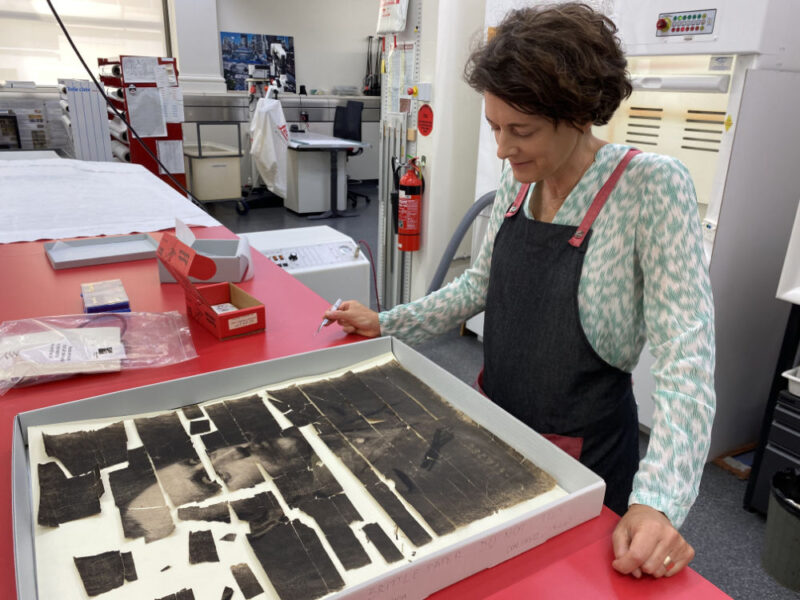
Above: Katy Glen preparing to consolidate a friable charcoal drawing.
Our Exhibitions and Loans Conservator, Amanda Wild, has been working on the relocation of the Ned Kelly armour display, including investigating active environmental controls within a custom-made showcase.
Marika Kocsis has commenced a condition survey of a unique collection of architectural drawings by English gothic revivalist William Butterfield, the original architect of Melbourne’s St Paul’s Cathedral. Many of the plans are life size and contain extremely detailed instructions on a variety of support papers. This project has been made possible through a generous donation from the Vera Moore Foundation.
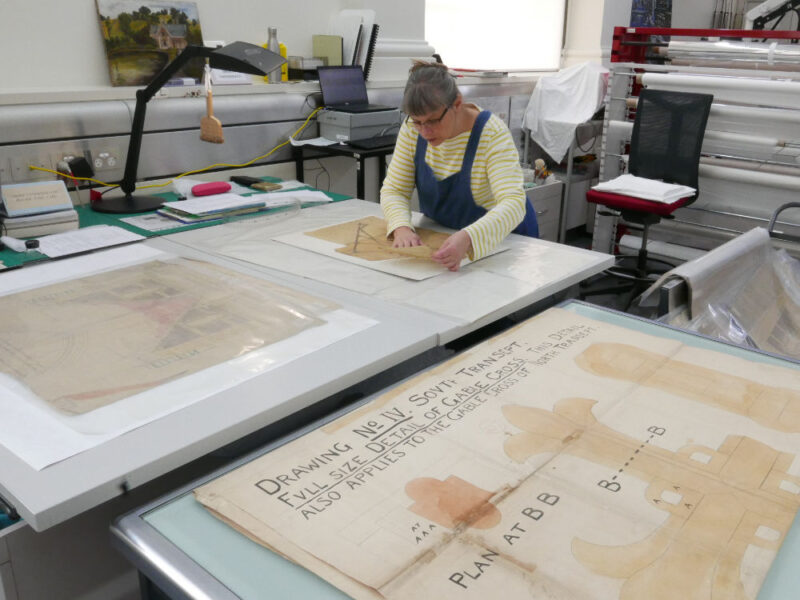
Above: Marika Kocsis surveying Butterfield collection of architectural drawings.
Ian Cox is working on an unusual late-17th-century full calf-leather binding from the Library’s John Emmerson collection of rare English printed books. The book has split in two, due to a combination of mechanical problems inherent to the tightback binding, deteriorated spine leather and handling. Several treatment options were discussed by the book team with the final decision being to underback the book with a new leather spine. Rather than duplicate the original and problematic tightback, it was agreed that using a hollow lining was a good compromise to protect the original deteriorated spine when opening the volume. It is a group effort with other members of the conservation team providing invaluable assistance with extensive paper repair.